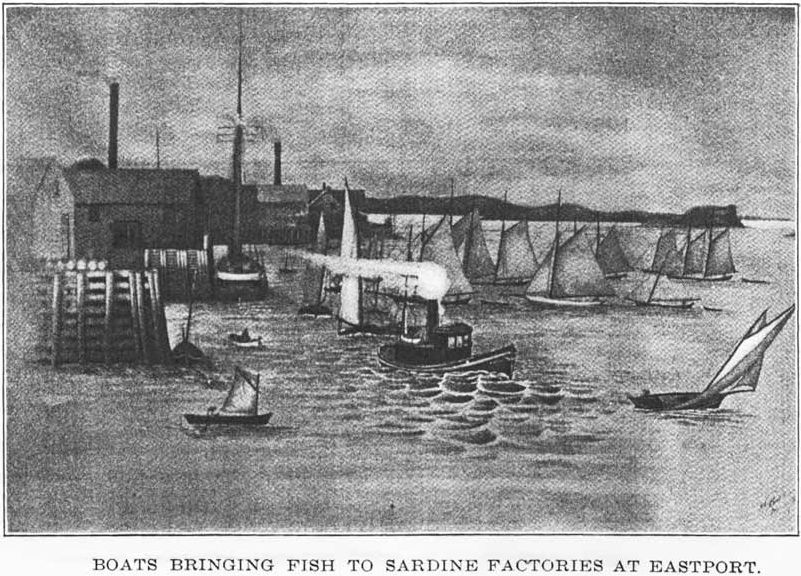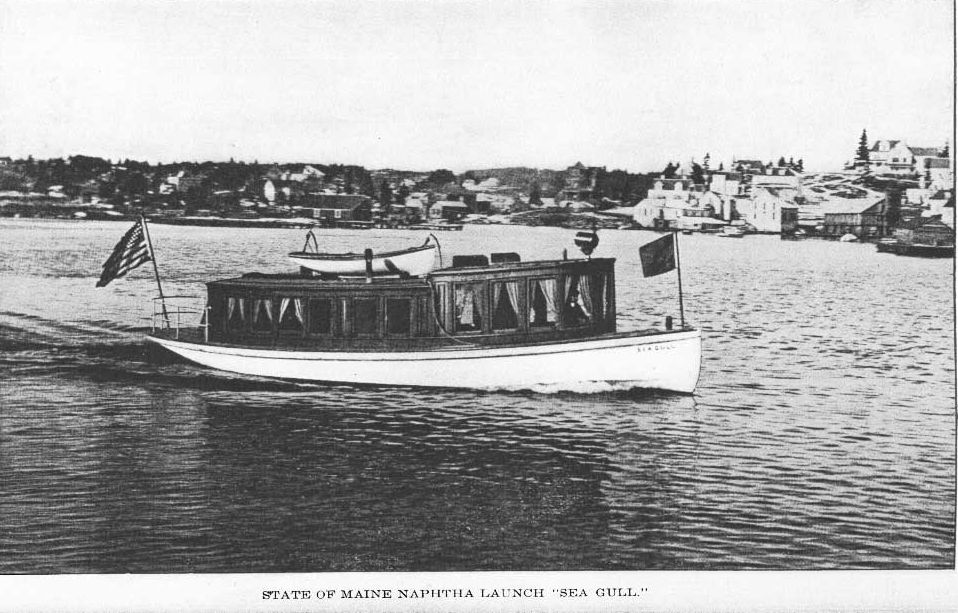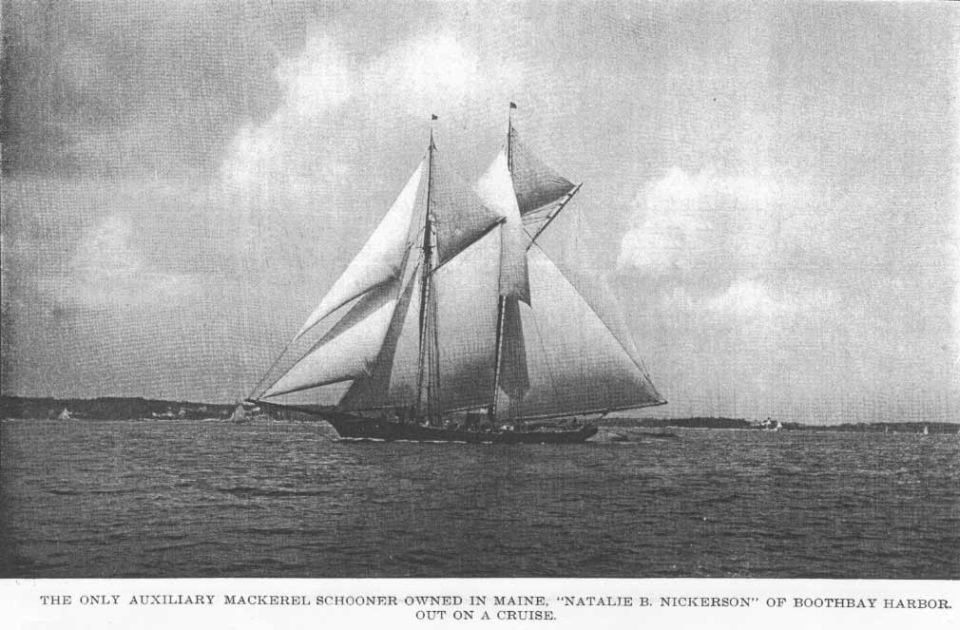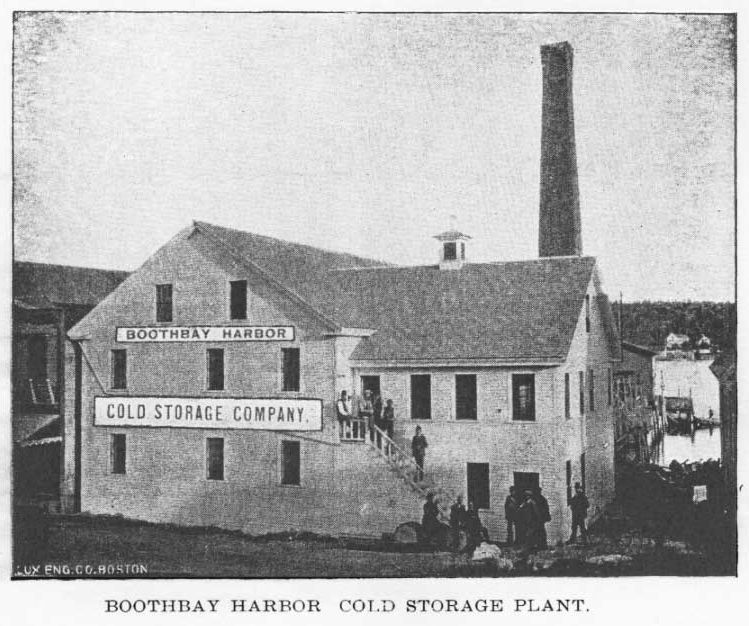Twentyeighth Report of the
Commissioner of Sea and Shore Fisheries
of the State of Maine.
for 1903 and 1904
AUGUSTA
KENNEBEC JOURNAL PRINT
1905
-------------------------------------------------------
TABLE OF CONTENTS.
Letter to Governor Hill 8
Commissioner's report 9
Alewife fishery 60
Alewife fishways 60
Alewife tables of detailed information 63 & 64
Bass in summary tables— Table 21 for 1904
Clam fishery 51
Clam culture 51
Clam tables of detailed information 55 and 56
Collins, Joseph W. Brief life history 82
Cunners in summary tables— Table 21 for 1904.
Eels in summary tables— Table 21 for 1904.
Fisheries—Grand summary, 1903 Table 21 for 1903
Fisheries—Grand summary, 1904 Table 21 for 1904
Fisheries—Summary of investments, 1903 74
Fisheries—Summary of investments, 1904 75
Fisheries—Persons employed, 1903 76
Fisheries—Persons employed, 1904 77
Flounders in summary tables— in Table 21 for 1904.
Ground fisheries 65
Ground fisheries—tables of detailed information 66 and 67
Herring fishery. 13
Herring —table of detailed information 15 and 16
Inspectors of pickled fish—list of— 81
Legislation recommended 37
Lobster convention in Boston 26
Lobster fishery 19
Lobster legislation in New York and New England states 25
Lobster tables of detailed information 49 and 50
Mackerel fishery 68
Mackerel tables of detailed information 69
Menhaden fishery 72
Menhaden tables of detailed information 73
Oil in summary tables In Table 21 for 1903 & 1904
Oyster culture in Maine 51
Persons employed in fisheries, 1903 and 1904 76 and 77
Salmon fishery 71
Salmon tables of detailed information 71
-------------------------------------------------------
6 CONTENTS. PAGE
Sardine industry and tables 17 and 18
Scallop tables of detailed information 55 and 56
Smelt fishery 57
Smelt tables of detailed information 58 and 59
Shad fishery 70
Sounds, hake, in summary tables— Tables for 1903 and 1904
Sword fish, in summary tables— Tables for 1903 and 1904
Tomcod, in summary tables— Tables for 1903 and 1904
Tongues and sounds, in summary tables— Tables for 1903 and 1904
Wardens, list of 79
Death notice and brief life history of Joseph W. Collins, late
president of Massachusetts Fish & Game Commission. 82
Illustrations.
Auxiliary Mackerel Fishing Schooner, Natalie B. Nickerson. 70
Cold Storage plant at Boothbay Harbor. 72
Naphtha Launch "Sea Gull" owned by the State. 22
U. S. Lobster Hatchery at Boothbay Harbor. 38
Sardine Factory, Eastport, Maine. 18
Sardine boats unloading, Eastport 22
-------------------------------------------------------
STATE OF MAINE.
Department of Sea and Shore Fisheries
Boothbay Harbor, Maine.
December 31, 1904.
To His Excellency, John F. Hill, Governor of Maine:
SIR: I have the honor to present herewith, as required by law,
the biennial report of this department for the two years
ending November 30, 1904.
Respectfully,
ALONZO R. NICKERSON, Commissioner.
---------------------------------------------------------------------------------
9 Maine Sea and Shore Fisheries 1903-1904
REPORT.
The total aggregate yield of all the fisheries of the State of Maine for the period of this report is four hundred and twenty-six million four hundred and three thousand four hundred and twenty pounds. The total value, including the value of the pack of sardines, is fifteen million seven hundred and seven thousand five hundred and sixty-one dollars.
These figures show the magnitude of the business, and its importance to the State and the nation. No other industry in the State equals this in magnificence of its industrial and economic results.
In 1903 17,843 men were engaged; in 1904 there were 18,175 men. From their efforts this handsome return is shown. The average man caught and produced each year 11,838 pounds, and the average return per man was $197.55 per year. The average investment, in stands, plants, boats, gear and apparatus to men engaged, was $175.
The average price received for the catch was $1.66 per hundred pounds.
The total investment in all the fisheries and connected industries was, in 1903: three million one hundred and sixty-one thousand three hundred and fifty-six dollars, and in 1904: three million one hundred and forty-four thousand three hundred and forty-seven dollars.
In value of production the following table will show the value in seven counties for 1903 and 1904.
County_____ Value, 1903.___ Value, 1904.
---------------------------------------------------------------------------------
10 Maine Sea and Shore Fisheries 1903-1904
I believe that the figures shown above for Lincoln and Washington Counties have never been equaled.
In quantity of fish taken Washington makes the largest return for both years, 1903 81,388,029 pounds, and in 1904 107,630,496 pounds.
The total number lobsters caught by 2,558 fishermen in 1903, with 153,257 pots is 7,494,691, at a value of $1,219,949, which yielded an average to each man the sum of $476.91, to each pot used an average of 49 lobsters.
The total number caught by 2,509 fishermen in 1904 with 164,720 pots is 6,904,888, valued at $1,066,879, which yielded on an average to each man the sum of $425.22, to each pot used an average of 42 lobsters.
In 1899 the average catch to each pot was about 39 lobsters
The several tables will be found under the appropriate titles, and the general table of investments, persons employed, and grand summary for both 1903 and 1904, will be found together at the end of report.
In making the figures in the grand summary tables it is necessary to reduce all products to pounds, therefore I explain that barrels of fish of all kinds are reckoned two hundred pounds; box herring, five pounds; bloaters, forty pounds per box; oil, seven and one-half pounds per gallon; scallops and clams, twelve pounds per gallon; clams, ten pounds of meat to the bushels, in shell; clams canned, fifty pounds per case; alewives, one-half pound each, lobsters, one and three-quarters pounds each.
In value of catch both in '03 and '04 the lobster fishery takes the lead of all the fisheries of the State, the aggregate being 25,199,263 pounds, valued at $2,286,828. This is a reduction as compared with the two years '01 and '02 of more than 3,000,000 pounds in quantity and $46,488 in value.
The largest catches were made in Lincoln County in 1904, and Knox County in 1903.
---------------------------------------------------------------------------------
11 Maine Sea and Shore Fisheries 1903-1904
It is hoped that the operation of the U. S. Lobster Hatchery at Boothbay Harbor, coupled with the collection and liberation of lobsters with eggs attached, will make the lobster more plentiful in our waters, and that increased catches in the future may be the result.
The largest fishery in quantity is the herring; 230,143,100 pounds being the catch of 1903 and 1904.
Washington County makes largest return, and Lincoln is second.
The sardine pack is unusual in volume, with a production of 2,827,027 cases and value of $8,610,802 for '03 and '04. The total number cases sardines packed in 1903 is 1,181,370.
The total number cases sardines packed in 1904 1,645,657.
The investment in the herring and sardine business in plants, boats, steamers, traps, and fishing apparatus was $1,178,395 in 1904.
The ground fishery yielded a grand total of 84,261,366 pounds, valued at $1,702,707.
Knox County makes largest returns.
While the bank fishery has been very poor the "shack" fishery has been very successful, and brought in large fares of iced fish. Many new vessels are to be added to the latter class of fishermen. These vessels are called "shackers," and their fares are mixed ground fish varieties.
The clam fishery is one of the most important in the State. For the period of this report, with an average investment in the business Of $36,073, the production was 12,975,054 pounds, of a value of $650,034.
For every dollar invested the return was more than 1800 per cent per year; for each dollar used 360 pounds of clam meats were produced.
While the above is a good showing, there is no good reason why this fishery should not be greatly increased by systematic cultivation on a large scale. This can be done by State control and the cultivation of clam producing grounds by the State on a large and comprehensive scale and plan. The evidences are unmistakable of the final extinction of the clam in portions of the areas, at least, which are now being overfished in our effort to supply a constantly increasing demand.
In other States scientific cultivation and propagation is in operation, and there it is a pronounced success in all respects,
---------------------------------------------------------------------------------
12 Maine Sea and Shore Fisheries 1903-1904
having gone beyond the experimental stage and become very profitable and constantly increasing.
The smelt fishery for 1903 and '04 shows a yield of 2,011,040 pounds, worth $199,489. The average price was, therefore, for that period $9.91 per hundred pounds.
This fishery should make a large showing in the future; at the same time I call attention to the fact of a large increase over other years in above figures.
That the always and everywhere popular Maine salmon should not show better, rather than reduced, aggregate is a surprise to me. There is never lack of market for this very valuable fish, and I think there should be a larger return.
The tables show a reduced catch compared with two years ago.
The shad fishery produced 2,403,000 pounds, worth $86,899. This is a considerable gain over 1901 and '02, and a still larger production can be made in the future.
The alewife catch aggregates 4,791,050 pounds, worth $43,989. This is an unsatisfactory return. I have referred elsewhere in this report to the neglect of this fishery, and proposed methods of increase.
The production of the menhaden fishery is about 5o million pounds, valued at $270,800.
My last report made no return as to this fishery because no schools of menhaden were on our coast.
The investment in plants and steamers in the business in '03 and '04 was $300,000.
The outlook for the fishery has been most discouraging for several years, but the return of quite large bodies of fish to our waters has given a new impetus to the business.
The fact that the menhaden taken in Maine waters are so much richer in yield of oil than fish taken elsewhere is the reason that the large factories in Lincoln county have been kept up at great expense. It is hoped that the fish may return again to this section in the numerous schools and incalculable numbers of former years.
---------------------------------------------------------------------------------
13 Maine Sea and Shore Fisheries 1903-1904
THE HERRING FISHERY.
There has been some dispute through the newspapers by the sardine packers as to the total pack of the season, some of the packers thinking that too large a pack was reported by this department for 1903.
I have only this to say in explanation: The wardens obtain their information daily and monthly from the packers and report the same to me at the end of each month, and if the packers report their pack incorrectly they alone are responsible for any error.
During the years 1903 and 1904 I have seen more than ever before the need of a change in our present laws, which now do not allow herring taken in certain waters excepting -in certain ways. Many days during this season, thousands of dollars might have come to the different counties if the law had allowed the herring to be taken when and wherever found.
In Washington and Hancock counties there has in the past been quite a general sentiment against the use of seines in the herring fishery, but this season has, I think, demonstrated to those who are connected with the herring fishery that they should have the same laws in the eastern counties that are in force in counties west of the west shore of the Penobscot river. My opinion is that we cannot with any good result legislate to either lessen, increase, or keep good the supply of herring on our coast—take them whenever and wherever they are found. The great ocean is their home, and any contrivance of man to catch them will not apparently lessen the quantity on our shores. Any fish that has the great ocean in which to roam and spawn is not to be relied upon to frequent every season any one locality, but in my opinion will be found where certain temperatures exist and food plentiful.
Some seasons these fish are on the coast of Maine in vast numbers, other years they are not with us; thus it behooves us to make the best of them when they are with us.
---------------------------------------------------------------------------------
14 Maine Sea and Shore Fisheries 1903-1904
Not so, however, with the shad, alewife and salmon, which go to our rivers and ponds to breed.
In the foregoing, in referring to our herring, it must be understood that herring and sardines are one and the same species.
The herring catch for 1904 was larger than for many years, more than twenty-eight million pounds over 1903, and about thirty-two million pounds over 1902. While the catch in pounds for 1904 was thus largely in excess of former years, the return to the fishermen was $145,000 less than 1901, and $92,000 less than 1903. For the year 1902, with a catch almost thirty-three million pounds under that of 1904, the fishermen received only $16,000 less than was returned to them the latter year.
I believe the last two years have been profitable to the fishermen and trap owners, and while the prices for the fish have been varying on account of the weather, condition of the demand, and uncertainty of fishing generally, all are satisfied with the year's work.
The following tables contain full information in detail by counties of this important industry for both 1903 and 1904.
--------------------------------------------------------------------------------
15 Maine Sea and Shore Fisheries 1903-1904
TABLE No. 1.
---------------------------------------------------------------------------------
16 Maine Sea and Shore Fisheries 1903-1904
TABLE No. 2.
Showing in Detail and by Counties, Statistics of the Herring Fishery in the State of Maine for the Year 1904.
Includes smoke-bouse employees, who were paid in Washington county, $4,687; Hancock, $12; Lincoln, $1,550; Cumberland, $450; total $4,899. t Includes 1,284 nets, 386 seines, 356 weirs, 16 traps.
In this item of boats and steamers are included, Washington county 24 steamers, valued $133,000; Hancock 5, valued $20,000; Knox 3, valued $11,000; Lincoln 15, valued $24,575; Cumberland 1, valued $1,500.
In Washington county two fertilizer plants valued at $45,000, in Lincoln county one fertilizer plant valued at $2,000. Hancock county produced 500 gallons oil, valued at $125. Total production in these counties 95,800 gallons of oil, worth $19,225. One can-making plant in Washington county, valued $50,000, and two in Cumberland county, valued $600, will be found in Table No. 19. Washington county produced 1,905 tons of scrap, valued at $27,800; Hancock county, 255 tons at $840; Lincoln county, 130 tons at $1,800; Cumberland county, 25 tons at $62. In Cumberland county were packed 3,881 cases of herring, worth $9,304; in Washington county 300 cases of kippered herring, worth $1,200. Lincoln county has one cold storage plant at Boothbay Harbor, valued at $8,000, used for preserving herring, and the sum of $3,000 was paid for labor at the plant. York county has also one plant used for same purpose, valued at $900.
------------------------------------------------------------------------
17 Maine Sea and Shore Fisheries 1903-1904
TABLE 3. Sardine Canning in the State of Maine by Counties for the year 1903
-------------------------------------------------------------------------
18 Maine Sea and Shore Fisheries 1903-1904
TABLE 4. Sardine Canning in the State of Maine by Counties for the year 1904
The product was put up in the following manner:
1,267,823 cases oils.
1,645,657 cases.
Knox county put up 31,475 cases 1/4 oils, 415 cases 3/4 mustard, 100 cases 1/4 spiced. total, 31,990 cases.
Washington county put up 1,109,607 cases 1/4oils, 258,766 cases j mustards, 44,607 eases I mustards, 6,303 cases & oils, 618 cases j spiced, 296 cases .1. mustard, 566 cases tomato, total, 1,420,714 cases.
Hancock county put up 79,446 eases oils, 204 cases oils, 20,862 cases mustards, total, 100,512 cases.
Lincoln county put up 47,295 cases oils, 424 cases oils, 37,960 cases l mustards, 3,910 cases j mustards, 894 oases I spiced, 1,814 cases spiced, 105 cases I tomato, total, 92,402 cases.
160 barrels Russian sardines were packed in Washington county valued at $560. 21 barrels Russian sardines were packed in Knox county valued at $73.
527 cases of herring (round cans) were packed in Washington County valued at $2,348.
166 cases of herring (round cans) were 1packed In Lincoln county valued at $M.
---------------------------------------------------------------------------------
PHOTOGRAPH: A busy day at the Sea Coast Canning Company's sardine factories in Eastport, Maine.
---------------------------------------------------------------------------------
Sea and Shore Fisheries 19
THE LOBSTER FISHERY.
The lobster catch has not been equal to that reported two years ago. The decrease for the term of the report has been more than three million pounds.
The immediate cause of this falling off has been, perhaps, the loss of gear occasioned by the heavy gales and storms that swept our coast during the winter, destroying large numbers of traps and making the fishery more than ordinarily hazardous to those in the business. The fishermen have suffered greatly from cold and escape them to return with very small or no catch at all, and casualties have been few. The boat fishermen during the winter months daily face almost unsurmountable perils and dangers, and escape them to return with very small or no catch at all and often to report the loss of part of their traps.
The winter of '04 was exceptionally severe, and the losses to the fishermen, both in catch and gear, have been very large.
The working of the "picked out meat bill" has been most satisfactory in all sections of the State, the peddling of the dissected and disguised "short" lobster has been stopped, and the man or woman who has heretofore got his or her surreptitious lobster at run-and-hide price will now pay the fisherman or dealer for the legal article and in the open.
The seed lobster bill was an experiment, but I think it is working well and is accomplishing, what its framers intended. It saves from destruction the lobsters carrying eggs, and will increase their numbers in our waters.
In my opinion it is the most important bill ever enacted in relation to the lobster. I believe this law is universally respected by the fishermen.
I insert the following as a leading article from the Lewiston Journal of June 18, 1904.
------------------------------------------------------------------------
20 Maine Sea and Shore Fisheries 1903-1904
Another Phase of Nullification.
Some of the Maine newspapers seem to be condoning infractions of the short lobster law on the basis that the law is wrong. Without discussing that phase of it, we suggest that the issue isn't whether the law is wrong or right. We have had doubts about the wisdom of the law. Sometimes it doesn't seem to be doing much good. One group of scientific authorities seems to hold the opinion that the short lobster can more safely be taken than the large lobster since it is the large lobster that propagates, but it is also evident that there must be some limit to the size at which the young may be taken, else all of the possibilities of market value of growth be lost.
But, as we have said, this does not appeal to us so strongly as does the feature of general respect for law. Nullification of laws according to individual taste is a dangerous policy to preach and we don't believe that the fisherman will bear it with any degree of complaisance. It is the same specious argument that we have heard from sheriffs and candidates for sheriff who have promised to enforce certain other laws—not as the law declares but as they esteem public sentiment to require. The fact is that respect to law is a mark of good citizenship. Serious as it may seem to be compelled to fine or imprison a man for having a bunch of short lobsters in his possession, we assume that the citizen who has knowingly broken the law, will accept his penalty in proper spirit, and will neither ask that any official shall nullify any law in his behalf or that any newspaper inform him that he is being persecuted. If the law is scientifically wrong, repeal it, but so long as it is a law let's abide by it and relieve our friends, the nullification-press, from their sympathetic appeals to the natural tendency of all of us to decry the law that steps upon the toes of our weaknesses.
The following law was enacted at the session of 1903:
CHAPTER 216.
An Act for the Protection of Lobsters with eggs attached. Be it enacted by the Senate and House of Representatives in Legislature assembled, as follows:
---------------------------------------------------------------------------------
Sea and Shore Fisheries 21
Section I. The Commissioner of sea and shore fisheries is hereby authorized and empowered to purchase at a rate not exceeding twenty-five per cent above the market price, lobsters with eggs attached, caught along the coast of Maine. Whoever catches any such lobsters with eggs attached, may safely store the same in lobster cars or sections of cars used for that purpose only, and may keep them separate from other lobsters until such time as the said commissioner or some person or persons designated by him can gather and pay for them. Said commissioner and his agent shall liberate them in the vicinity of the location where they were caught; or he may at his discretion sell any portion or all of them to the officer in charge of the United States fish hatchery for artificial propagation, the proceeds to be applied to the appropriation made for the enforcement of this act.
Section 2. The sum of seven thousand five hundred dollars, or so much thereof as may be necessary, is hereby appropriated for carrying out the provisions of this act in the year nineteen hundred and three, and five thousand dollars for the year nineteen hundred and four, to be used at the discretion of the commissioner of sea and shore fisheries.
In the carrying out of the law it was very necessary to have a boat, and an open launch with naphtha power was purchased and used for the year 1903, when it was satisfactorily shown that this boat would very well perform the service with some alterations. In 1904 a house was built with engine room, kitchen, pilot house, and sleeping room, all conveniently arranged for two persons to live comfortably on board, and now the State has a boat, the "Sea Gull," which is the equal of any of its size for this particular business in New England, and I will say that the launch Sea Gull comprises the entire navy of the State of Maine.
Massachusetts, during the last session of the legislature, enacted the same law providing for the purchase of lobsters with eggs attached, such as Maine now has.
The purpose of this law was to put an end to the wholesale destruction of lobster eggs. The lobster when caught with eggs attached was stripped of the eggs, which were thrown away, and the lobster sold. Thus not only the eggs to the number of many millions annually were lost, but the mother lobster was also destroyed.
------------------------------------------------------------------------
22 Maine Sea and Shore Fisheries 1903-1904
The "Sea Gull," Capt. L. S. Nickerson, has been very busy collecting the egg-bearing lobsters. There was at first considerable difficulty in inducing the fishermen to save the lobsters and keep them for future collection. It was certainly much trouble to them, but I will say that generally after fully explaining the purpose of the law we have had the co-operation of the men in the business, and the plan is conceded to be very advantageous ultimately to the fishery, and at the same time eliminates the incentive to destroy the eggs and sell the adult female.
The U. S. Fish Commission has assisted this department by making collections for a part of the season in the western section of the State waters. It has also secured an artificial saltwater reserve in Lincoln county and is experimenting in the keeping of lobsters therein, awaiting transportation to the hatchery, and for other purposes of observation and investigation under natural conditions.
The following report for the two years 1903 and 1904 shows the magnitude and importance of this duty performed by the "Sea Gull," and it will be interesting to learn as to the collection and dispersing of the lobsters, and millions of fry hatched from them and returned to our waters.
Account of purchase from fishermen of egg-bearing lobsters, and disposition for the year 1903.
Number purchased from March to November 30 14,173
DISPOSITION.
Transported to U. S. Hatchery at Gloucester, Mass., for scientific investigation and propagation of eggs: 1,925.
Impounded at the U. S. Reserve in Bristol, Lincoln County to be cared for by U. S. officials: 6,801.
These were in the following spring taken to the Gloucester, Mass., hatchery, the eggs hatched, and the mother lobsters all returned and liberated near the place of purchase.
Number liberated at time and place of purchase5,447
---------------------------------------------------------------------------------
Maine Sea and Shore Fisheries 23
The young hatched from the above eggs were cared for at the Gloucester hatchery, and were subsequently brought here and deposited to the number of 32,700,000 eggs, as will appear by reference to the following table for 1903.
LOBSTER FRY PLANTED IN MAINE WATERS, 1903.
Date of Plant Number fry planted Point of Deposit
June 5 1,200,000 Casco Bay, near north shore, Great Diamond Island.
July 2 500,000 Gulf of Maine, Richmond Island Harbor.
Total fry planted on Maine coast. 32,700,000
Account of purchase by this department of egg-bearing lobsters, and what was done with them for the year ending November 30, 1904.
Number bought from November 30, 1903, to November 30, 1904 16,076
Quite a number of lobsters were caught and re-purchased.
1903 1904
Number punched 2d time 396 310
---------------------------------------------------------------------------------
24 Maine Sea and Shore Fisheries
For the information of those interested I will state that when a lobster is purchased, before being released a small hole is punched in the middle flipper, thus it will be understood that in 1903, for instance, nine lobsters were released, being marked with five perforations in the flipper, and in 1904 one was decorated with five punch-holes before liberation.
The lobsters taken to Gloucester as above to the number of 10,284 were, after the eggs were hatched, returned and liberated. Young lobsters hatched from the eggs to the number of 53,950,000 were subsequently distributed in our waters along the shore.
The following table for 1904 shows the point of deposition and the number deposited at each place. The total number of young lobsters therefore deposited in our waters in both years being 86,650,000.
LOBSTER FRY LIBERATED IN MAINE WATERS, TO JUNE 25, 1904.
Entrance to Monhegan Harbor 1,500,000
Total 53,950,000
---------------------------------------------------------------------------------
25 Maine Sea and Shore Fisheries
LOBSTER LEGISLATION IN THE NEW ENGLAND STATES AND NEW YORK.
Uniformity of action has been and is desired in the lobster producing states as a very important desideratum. The demand for this most valuable food fish is constantly increasing and the market extending, while the fishery confined to the waters within the jurisdiction of those states, and also the British Maritime Provinces, is being depleted. Only with increased appliances and number of fishermen, and enlarged and extended field of operation generally, is the demand supplied under stringent restrictive and regulative statutes. It is certainly unwise to further restrict by close time, or otherwise, the production as advocated by many while the volume of that demand is certainly on the increase.
The demand for a product, and more vitally a food product, is the most valuable and certain indication of that business prosperity, and it would seem that we should bring by rational and proper action and concert, the supply and demand into a fair equilibrium at least, by increasing the former if practicable rather than restricting the latter by reducing the catch through legislative action.
Only after an effort to increase or conserve the supply or save the fishery from extinction should further restrictive measures be put upon the market demand for the lobster. Close time is always a favorite measure as a short cut in game and fish protection. Size limit is feasible and practicable, and has been proven satisfactory and preventive in Maine waters; whether logical as practiced is debatable, certainly.
Close time, except for a series of years, in the capture of the slow growing and sedentary lobster is unreasonable. The only effect of an annual or short, seasonable close time would be, whenever in the year occurring, to reduce the time during which the lobster would be subject to attack by fishermen.
---------------------------------------------------------------------------------
Maine Sea and Shore Fisheries 26
And this would be of little avail, for by greatly increased number of traps and men in this business and redoubled effort, the fishery would be just as effectually cleaned up as would be the case with normal effort and all the year's fishing.
'Tis a fact that close time causes more energetic fishing while allowed, and too close, or over fishing, will cause sudden movement of the decimated and too sharply hunted species and at least local extinction.
THE LOBSTER CONVENTION IN BOSTON.
With a view to free interchange of opinions and possible concert of effort to preserve the lobster by the several lobster producing states, the Legislature of Massachusetts by act of May 15th, 1903, authorized the Fish Commissioners of that State to call a convention of the commissioners of the several states, and of the British Maritime Provinces.
Pursuant to this law this Department received the following invitation from the Hon. President of the Massachusetts Fish Commission.
"Dear Sir:—A convention of commissioners of the lobster-producing States and British Maritime Provinces will be held at room 249, State House, Boston, Wednesday, Sept. 23, 1903, for the purpose of considering what can be done to secure a better protection of the lobster, and, if possible, to obtain laws which are as nearly uniform as possible in the various States and Provinces. You are cordially invited to attend this convention, which we anticipate will be one of the most interesting and important ever held for the purpose of trying to prevent the ultimate commercial extinction of the lobster.
Yours respectfully,
J. W. Collins.
In response to this letter of invitation your Commissioner attended the convention and took part in its deliberation.
PROCEEDINGS OF THE CONVENTION.
Those in attendance at the convention were (beginning at the north): Mr. R. N. Venning, deputy commissioner of fisheries at Ottawa, and Mr. A. C. Bertram, inspector of fisheries for the island of Cape Breton, to represent the Dominion of Canada; Mr. A. R. Nickerson, commissioner of Sea and Shore fisheries of Maine; Messrs. Nathaniel Wentworth (chairman)
---------------------------------------------------------------------------------
27 Maine Sea and Shore Fisheries
and Charles B, Clarke, of the Fish and Game Commission of New Hampshire; Messrs. Joseph W. Collins (chairman), E. A. Bracket and John W. Delano, of the Fish and Game Commission of Massachusetts; Messrs. Henry T. Root (president), J. M. K. Southwick (vice president), Charles W. Willard, William H. Boardman and William P. Morton (secretary), of the Inland Fisheries Commission of Rhode Island; Messrs. George T. Matthewson (president) and E. Hart Geer (secretary), of the Fish and Game Commission of Connecticut; Mr. B. Frank Wood, State Superintendent of Shell Fisheries of New York.
In addition to the commissioners and delegates, there were present several experts, scientific and otherwise, besides gentlemen holding various views regarding the protection of the lobster. Among these were Dr. George W. Field, recently associated with the Massachusetts Institute of Technology, who has given much attention to the study of the lobster; Messrs. F. W. Morgan (secretary) and E. H. Potter, of the advisory committee of the Fishermen's Association of Connecticut; Mr. Edward W. Kelley, a deputy of the Rhode Island Commission; Messrs. T. L. Davis and E. L. Bonney, members of the Massachusetts Legislature; J. R. Reed, president of the Massachusetts Fish and Game Protective Association; Mr. H. H. Kimball, Secretary of the same organization; Messrs. G. L. Young, A. L. Young and Harvey (of the firm of Cox and Harvey), wholesale lobster dealers of Boston; Capt' Robert Conwell of Provincetown, ex-Representative to the Legislature, and owner of a fleet of fishing vessels; and Mr. Anthony Atwood of Plymouth, lobster dealer and lobster fisherman.
The Convention was presided over by Hon. J. W. Collins, the secretary was Dr. Geo. W. Field.
There was a very free discussion by the officials of the several states of the British Maritime Provinces, by scientific observers and investigators, fish dealers and prominent fishermen. All seemed to agree that the lobster was becoming smaller and scarcer everywhere in all waters.
As to the fishery in Provincial waters Mr. Venning of Ottawa, Can. spoke, in part, as follows: "This convention is no doubt a step in the right direction. It seems to me that what you are attempting to do to-day is to devise some means by which you can control and protect the lobster fishery of the United States
---------------------------------------------------------------------------------
28 Maine Sea and Shore Fisheries
in a way that will be nearly uniform in the several States .... Or, rather, it appears to me that you are looking to reproduce the lobster fishery that you once had.
Notwithstanding its present importance, we look upon the live lobster trade as almost in its infancy. It is engaged in almost exclusively from the south-western section of Nova Scotia, where this part of the lobster trade amounted to $ 1,113,485, which was a larger amount than the yield from canning in the same section of the coast, which reached a total of only $1,000,603.
Thus the bulk of the live lobster trade, which is at present conducted on the south-western coast of Nova Scotia where the traffic promises enormous development, constitutes an object lesson of the greatest importance, in considering the advantages to all concerned, and especially to the welfare of the lobster fishery, in the substitution of the exportation of large, live lobsters for the canning of undersized ones. The reason for this is obvious, and is to be found in the peculiar geographical position, combined with the facilities for transport.
The United States' markets for live lobsters are within a few hour's reach of a portion of this district, notably the counties of Digby, Yarmouth and Shelburne; and a large and growing trade has sprung up, which will probably extend farther north. The fresh lobster trade is controlled by the laws of the United States, so far as the length of lobsters is concerned. Of these it has been said:
" The wholesome laws of the United States touching the size limit will exclude undersized lobsters, and the incentive for their capture will cease; hence the matter will adjust itself, and cannot but inure to the lasting benefit of the lobster fishery as a whole.
In the Dominion of Canada there remains the last great lobster fishery of the world, and it is not too much to say that this fishery has reached a critical stage.
The signs of exhaustion are unmistakable. Small, immature lobsters, 5 to 8 inches long, which a few years ago were rejected with contempt, are now eagerly taken, and form, in some districts, the staple article on which the lobster canners depend. Instead of two or three lobsters sufficing to fill a one-pound can, not less than five, six, seven and even ten lobsters are now required.
---------------------------------------------------------------------------------
29 Maine Sea and Shore Fisheries
Ten years ago the average size of lobsters was 10 inches (2 pounds in weight), while 30 years ago an old fisherman has testified that 13 inches (3.12 pounds weight) was the average.
In order to keep up the catch each season, the quantity of gear is being increased year by year all around the coast, yet the average number of lobsters taken per trap has been steadily diminishing.
A prominent packer in Prince Edward Island publicly stated that at one cannery the number of cans packed, as compared with the number of traps operated, revealed that during a period covering six seasons the average number of one-pound cans to each trap was 24 in 1891, 16 3/4 in 1892, 13 ½ in 1893, 12 ½ in 1894, 7 3/4 in 1895, and 5 ½ in 1896.
This kind of thing can not continue; and the utilization of berried and soft-shelled lobsters is indicative of the desperate means resorted to maintain an aggregate pack."
Lobster hatching is carried on much more extensively in the Canadian waters than in the United States. Quoting Mr. Yenning further: "A lobster hatchery was established at Bay View, Pictou county, N. S., which has been successfully maintained and operated . . . to the entire satisfaction of the department, the aggregate output of healthy lobster fry within a range of sixty miles of coast being 1,439,300,000, the distribution of 1903 was 162,000,000. In addition to the above, a hatchery has been put in operation this season at Shemogue harbor, Westmoreland county, N. B. There are at present in course of construction two other hatcheries, one at Blockhouse Point, Charlottetown, P. E. I., and one at Shippegan Gully, Gloucester county, N. B., while the department is considering the selection from suggested sites for further lobster-hatching establishments.
The fry from the Bay View hatchery are distributed by small steamers along the coast line about sixty miles in the vicinity of the hatchery.
In connection with efforts to maintain the supply of lobsters by methods of artificial propagation and protection of the breeding fish, an interesting experiment was this year (1903) initiated at Fourchie, Cape Breton county, N. S., under the auspices of the department of marine and fisheries. An arrangement was made with Mr. H. E. Baker of Gaborous, a large operator in the canned and live lobster trade in Cape
---------------------------------------------------------------------------------
30 Maine Sea and Shore Fisheries
Breton Island, for the utilization of his lobster pounds at Fourchie, which were partitioned off for the reception of lobsters of different classes and in different stages.
The principle of the scheme was to purchase from the fishermen 50,000 desirable seed lobsters, and place them in a suitable pound for protection, where they could be retained and fed during such time as fishing operations were proceeding; after which, or when the eggs were sufficiently advanced, the lobsters were to be liberated along the coast whence they were taken, thus permitting such of them as had not already cast their fry in the pounds to hatch their eggs in their natural haunts, in conformity with the strict methods of nature.
A specialist of the department was sent to inspect the working of the scheme, and on the 5th of August he reported that the eggs were hatching out in millions within the enclosures of the pounds, and the young lobsters were making their way through the wire netting into the sea. At the time of his visit there were still in the pounds about 20,000 berried lobsters, the eggs of which were in various stages of development, while the enclosure was teeming with vigorous, newly hatched fry.
It is perhaps not too sanguine a conclusion to say that, so far as can be proved by the facts actually observed in the experience of those charged with the conduct of this experiment, its result was a complete success. At all events, these 49,769 mothers, with their progeny, were at least saved out of the actual catch of the fishermen, and would otherwise have found their way to the markets, either as canned goods, or exported alive, after the eggs had been raked off.
The fact that we have been able for twenty or thirty years to carry on the lobster canning to the extent that these statistics show, proves conclusively that the lobster must have had some assistance along the provincial coasts, through protection, artificial propagation, etc. There are 225 lobster canneries in Prince Edward Island, and the fact that they have maintained the pack and that the business is still going, I think proves that the protective measures for the lobster are to some extent effective."
It will be observed that the Dominion authorities bought for experimental purposes in the year 1903 49,796 seed lobsters, and the eggs were hatched from them naturally, but while the lobsters
---------------------------------------------------------------------------------
Maine Sea and Shore Fisheries 31
were confined in pounds, and during the same year, 162,000,000 young were distributed in sixty miles coast line, the latter eggs being hatched artificially at the Bay View station, Nova Scotia.
President Collins spoke as follows: I can scarcely claim to be inexpert regarding the lobster, for I have been familiar with it and have had it under observation for more than fifty years. It has been my privilege to make careful enquiries concerning it throughout its range of distribution in America—from the Delaware capes to the strait of Belle Isle—and also in northern Europe, where the lobster is a different species from ours, but differs chiefly in size.
As a child, with bared feet and legs, I often waded into the sea on the coast of Maine to a depth of a foot or so, and pulled big lobsters from beneath seaweed covered boulders, where they were generally found at low tide. When only ten to fifteen years of age I caught lobsters in the waters of Nova Scotia, Prince Edward Island, the Magdalen Islands, and Lower Canada; later I was a lobster fisherman on the cost of Maine; in 1879 and 1880 I collected information regarding the lobster and the lobster industry from Eastport, Me., to Delaware; and subsequently assisted in the preparation of an illustrated history of the lobster fishery of the United States. Since then my interest in the lobster has never ceased, and every opportunity has been utilized to gain additional information concerning it on my trips to Newfoundland, Labrador, and others of the maritime provinces, as well as to Maine and Europe.
It is not difficult, therefore, for me to recognize that conditions relating to the lobster and its protection may vary with location and difference of temperature or environment; also that there are many problems involved in these questions that are difficult to settle satisfactorily—that must be most carefully considered—especially in view of the fact that, in the final adjustment of these affairs, it will be necessary to have resort to the various State legislatures to secure desired legislation.
In regard to securing a uniform close season in the lobster producing states which may in a measure resemble the close seasons adopted in Canada, but be specially applicable to the mid-summer months, when, by common consent, the length-limit law is mostly violated, I can appreciate the force of what
---------------------------------------------------------------------------------
Maine Sea and Shore Fisheries 32
has been said by the distinguished commissioner from Maine; and it seems that, in this matter, local conditions are entitled to consideration, and may to a large extent control action.
From all over the country people go to Maine in spring or early summer to fish; later they go there or remain there to enjoy the beauties of nature by seashore or in the wilderness. But at all times these summer migrants want the products of the sea for food, and no other so much as the lobster. This is especially true of the sea coast residents; they will not be denied. One can therefore easily appreciate the objections we have been told may be made to a close season on lobster fishing by the Maine legislature, especially when it is understood that catering to the summer visitant is one of the most important industries of the State. One need not marvel that whatever affects the welfare or wishes of the summer colony may command respectful attention in the Maine legislature; it is idle to assume that those constituting it would not have consideration for this element.
It follows, therefore, that it might be exceedingly difficult if not impossible to secure a close season on lobsters in Maine, even if the commissioner of sea and shore fisheries of that State deemed it was necessary, considered from the standpoint of the scientific treatment of the lobster, with the hope and purpose of securing its protection from commercial extinction. The words "commercial extinction" are used, despite the fact that official statistics seem to show that there has recently been an increase in the catch of lobsters on the coast of Maine.
While in my judgment it is possible to maintain the present supply of lobsters in Maine waters, and perhaps to increase their abundance, this cannot be accomplished except by a loyal obedience to the laws on the part of the fishermen, such as has never been given. The result of the methods practiced there has been the same as elsewhere, a gradual diminution of the lobster supply in the sea since the beginning of the fishery; and all figures that show the contrary, however honestly and capably compiled, are misleading, as I will presently show.
The distinguished commissioner from Maine finds that during the past three or four years there has been a gradual increase in the yield of the lobster fishery in Maine, as shown by carefully compiled statistics that have been gathered by his deputies. This
---------------------------------------------------------------------------------
Maine Sea and Shore Fisheries 33
would seem to indicate that there has been an increase in the abundance of the lobster. If not, why this increase in the. catch? It is not necessary to seek far to find the cause.
The recent remarkable advance in the price of the lobster, especially accentuated in the winter, has led to the employment of a larger number of men and a still larger number of pots for the capture of lobsters. Also, whereas the lobster fishery was formerly pursued only six or seven months in the year—possibly eight months in extreme cases—it has gradually become customary in the these recent years for the fishermen to pursue their industry throughout the year, thus fishing about forty per cent of time longer than they used to. Besides this, the winter fishery has led to the exploitation of new grounds. Now the boats sometimes go out ten or fifteen miles from the land to fish, and fully investigate fishing grounds that they did not venture to visit five or six years ago. Thus the area of available bottom resorted to has been doubled.
Those of us who have given attention to these matters know that along the great coast line of Maine, which, with its indentations and islands, is more than two thousand miles in length, the lobster is still caught in large numbers, as compared with the product of any other section of the United States. They are now taken to supply the demands of the live lobster trade. Trains going out of Maine, or steamers departing from its harbors for Boston, carry many lobsters.
And, despite the fact that everything has been done that has seemed practicable in the way of enforcing the law, under the efficient administration of Commissioner Nickerson, the fact still remains, and it is indisputable, that literally millions of young lobsters, which have not yet attained maturity and been able to reproduce themselves, are either consumed at the coast hotels during the summer months, or else, at any time of year when the fishery is prosecuted, they may be transported into or through New Hampshire or Massachusetts to New York, Rhode Island, or Connecticut. Carloads that were passing through Boston have come under our observation. They were billed for New York, and, of course, could not be interrupted because of the interstate laws; otherwise, it is very probable that our courts would have had something to do with them, much to the satisfaction, I am sure, of our friend the commissioner of sea and shore fisheries of Maine."
---------------------------------------------------------------------------------
Maine Sea and Shore Fisheries 34
The convention in executive session appointed a committee to report recommendations for uniform legislation in the several states. The committee's report, which was unanimously adopted, was as follows:
I. We recommend that a law be enacted to limit lobster catching to men having permits from the State; that the penalty for catching lobsters without a permit shall not be less than $100 and that a person convicted of violating the laws for the protection of lobsters shall have his permit revoked, and that no other shall be issued to him for a year thereafter.
2. We recommend that it is desirable, if possible, to secure uniform or nearly uniform laws for the protection of the lobster in the new England States and New York, more especially so far as the length of the legalized lobster is concerned.
3. We recommend the general adoption of the law relating to lobster meat now embraced in the statutes of Maine.
I believe the deliberations of the convention will result in much good. The discussions were very free and cordial, and I hope the legislature will promptly adopt and follow the unanimous opinion of those present representing the states of New York, Connecticut, Rhode Island, Massachusetts, New Hampshire and Maine, expressed in the above report and recommendations.
I take this opportunity to thank the Massachusetts Department for the initiation of this convention, and its invitation and opportunity to attend its deliberations in the interest of the lobster fishermen of Maine, and I wish to express to the President and gentlemen of that commission my appreciation and acknowledgment of many personal courtesies shown me.
SUMMARY OF INTERESTING POINTS AND CONCLUSIONS BROUGHT
OUT DURING THE CONVENTION.
The effect of man's operations upon the lobster was cited as an evidence of the fact that man has ever been the cause that has led to a decimation of the species and a marked reduction in the size of the individual. There has been no exception. From Norway to Newfoundland, from the latter island to New Jersey, the story has been the same. Everywhere that a lobster fishery has been established there has been marked diminution of the species, (in cases reaching almost to extermination) and it has
---------------------------------------------------------------------------------
Maine Sea and Shore Fisheries 35
always become necessary for the government to step in and so regulate, control and increase the fishery as to delay final exhaustion of the supply.
The lobster fishermen of Connecticut very generally use power boats and their traps are hauled by motor power. Connecticut has but one statute relating to the lobster—as to legal size for catching and forbidding the catching of seed-bearing females. No statistics are taken of the lobster fishery, and no report made.
The state of Rhode Island buys seed lobsters, liberating them after taking the eggs for artificial hatching. The R. I. Commissioners find propagation by hatching artificially very easy and successful and the process simple.
New York State Commissioners hatch lobsters artificially at the State Fish Stations, and distribute them in state waters.
The Dominion government has established a varying close time, and also a varying size limit, restricting the lobster fishing in seven sections, into which the fishing grounds have been divided.
Among many regulations they have prohibitions as to the catching of seed lobsters; as to sale or purchase of fragment, or lobster meat, for canning purposes; minimum depth of water in which traps may be set; use of trawls for lobster catching in certain waters and inhibited waters. Maximum penalty one hundred dollars ($100.00) and costs, or three months' imprisonment; vessels and boats liable to confiscation.
All regulations of the lobster fishery are promulgated by order of council not requiring action by, or approval of, the legislature.
Canning, or putting up of preserved lobster, is allowed. Eight hundred and fifty-five factories are operated. All canneries are licensed, the amount of fee according to volume of pack; all packages stamped and numbered by government inspectors.
The machinery for carrying out and enforcing the regulation is somewhat complex, but entirely effective. Under the chief authority, the Ministry of Marine and Fisheries at Ottawa, are commissioners; assistant commissioners; inspectors in districts; fishery overseers in county; (inspectors and overseers have magisterial powers to try cases and enforce penalties and forfeitures within their respective districts).
Special fishery guardians are also locally employed. The patrol and protective work is done by four steamships, two sailing
---------------------------------------------------------------------------------
Maine Sea and Shore Fisheries 36
vessels, and four launches regularly employed. Two lobster hatcheries are now being built. The first regulation effecting the lobster fishery was made in 1873. In 1903 1,365,512 traps were used and the fishermen received seven and eight dollars per hundred.
The result of Professor Field's two years of investigation as to the best means to se
cure the protection and increase of the fishery is summed up in the following conclusions:
1. The number of lobsters great and small at present in the ocean is very markedly less than it was twenty, or even ten years ago.
2. The cause of the decrease plainly appears to be: (a) The, increased demand and consumption for food; (b) The existing laws which have been in full force practically since 1873.
3. The prime necessity for placing the lobster industry upon the best possible economic basis is a code of laws which shall be essentially uniform throughout the geographical range of the lobster where uniform conditions exist.
Such laws to be effective must be adapted for (a) increasing the supply of lobsters without limiting the demand; (b) must appeal to the common sense of the people as evidently likely to fulfil the purpose for which the laws were instituted; © must be adapted for rapid, effective, and inexpensive enforcement; (d) must be so framed as to work a minimum injury to vested interests and (e) must promise the best possible market conditions with reference to the public demands in regard to size, season, price, etc.
That the most promising path for securing the best possible supply of lobsters for all time lies through the protection of the adult lobsters, for it is obvious that the only possible source of an increased number of lobsters is an increased number of eggs.
The convention adjourned Sept. 24.
NOTE.—Since the writing of this report I have received the very sad news of the death of Hon. Joseph W. Collins, President of the Massachusetts Fish Commission, who was instrumental in calling this convention, and who presided over its deliberations.
Mr. Collins was a laborious investigator of fishes from a practical, rather than scientific and technical standpoint. He was a writer of prominence in this chosen field of investigation, and was considered an authority over all questions in relation to
---------------------------------------------------------------------------------
Maine Sea and Shore Fisheries 37
practical fishery. His eminence in this specialty was reached through personal endeavor, great industry, patient study and, application, rather than educational advantages, of which he had but meager opportunity to avail himself in his youth. He was born in Maine. His death will be mourned by friends all over the country, while the fisheries and the fishermen of the world suffer the distinct loss of an earnest, honest, enthusiastic, able representative and advocate.
A brief life history of Mr. Collins will be found in the appendix.
The suggestions of the lobster convention as to a law granting permits to lobster fishermen I recommend adopted by the enactment of a law in substance as follows:
No person or corporation shall engage in the lobster fishery in this State without a permit from the Commissioner of Sea and Shore Fisheries, which permit shall be furnished free of cost to the applicant and shall contain a copy of the laws for the protection of the lobster.
Any person who engages in lobster fishing without a permit from the Commissioner shall forfeit not less than one hundred dollars, or be liable to imprisonment, or both fine and imprisonment at the discretion of the court.
A person holding a permit who is convicted of a violation of any of the lobster laws shall surrender his permit to the Commissioner, and it shall not be re-issued within one year from the date of surrender.
Failure to surrender a permit shall make the holder liable to a penalty of not less than fifty dollars.
A similar law will be presented to the legislature of Massachusetts, New Hampshire, Rhode Island, Connecticut, and New York by the commissioners of these states. Uniform laws as to the length limit will be prepared and adopted as far as possible, conforming generally, I think, to Maine's limit of 10 ½ inches.
The fishery laws of Maine, public and special, should be revised at this session of the legislature. Many of them are conflicting, contradictory, uncertain, and often are 'impossible of intelligent interpretation and of enforcement. Some should be repealed and all should, early in the session, be committed into
---------------------------------------------------------------------------------
Maine Sea and Shore Fisheries 38
the hands of a competent attorney, as a commissioner, to revise and report such recommendations for repeals, amendments, and corrections as may be required and early enough for action of the present session, and this I earnestly recommend.
The following is a synopsis of a paper read by your Commissioner by invitation of President Carleton before the convention of the North American Fish and Game Protective Association, held at Portland, January 20, 1904. This is inserted, thinking it may be interesting to many as a history, in brief, of the lobster business for the past sixty years.
The idea of a falling off in the abundance of lobsters on the coast of the United States is not of recent origin, as protective laws were enacted over seventy years ago, and about every lobster-producing state in the Union has restricted the lobster fishery within its own waters by more or less stringent legislation. Probably no better argument than this could be used to show that there must have been a falling off in the supply up to 1895, but it is not, in the judgment of many, (the writer included) sufficiently proved by facts that they are still decreasing in Maine. There is no doubt in my mind but that previous to the time of the establishment of canning factories in our State there were more lobsters on the coast of Maine than are there to-day. I have every reason to believe that since 1895 (when legislation caused the canneries to stop) the lobsters on our coast have gradually increased in numbers. It must be remembered previous to 1895 nearly everything in a lobster shell was used at the canneries regardless of size; since 1895 only those above 10 ½ inches in length can be lawfully used anywhere in our State, therefore if we add to the present year production, what are left in the water below 10 ½ inches, imagine what an enormous quantity we would have.
I am, a firm believer in the present Maine lobster laws and I firmly believe that with the proper observance and enforcement of what laws we now have, we can, within the next twenty years, supply the market of the United States and prices will not average as high as they do today.
With the hatchery in operation which the United States has just erected at Boothbay Harbor; the purchase and liberation of seed lobsters in our waters, and the protection of those lobsters
---------------------------------------------------------------------------------
Maine Sea and Shore Fisheries 39
measuring less than 10 ½ inches, the supply of lobsters in our waters must appreciably increase.
I find that as far back as 1812 Provincetown, fearing the extermination of the lobster, induced the legislature to enact a law imposing a fine if lobsters were taken from the waters and shores of the town without permit from the selectmen, and providing for the appointment of several wardens, etc.
The first restrictive law as to lobsters was passed by our State in 1879, which restricted the canning to the months of April, May, June, and July in each year, and none were allowed to be caught during the other months measuring less than io% inches in length.
In 1883 the foregoing law was changed by making a close time extending from August 15th to November 15th, and allowing no lobster less than nine inches to be canned, and no lobsters with eggs attached to be taken.
In 1885 this was changed by making close time extend from August 15th to October 1st, and allowing canning from April I St to July 15th, providing also that no lobster with eggs attached should be saved, or that any measuring less than nine inches should be canned.
In 1891 another change was made shortening the time in which lobsters might be canned, this time allowing it done only from April 2oth to July 1st in each year, and in 1895 the legislature passed a law that allowed no lobster less than io% inches to be handled for any purpose. This meant the extinction of the business of canning lobsters in Maine.
Since the date when this law took effect no lobsters have been canned and no changes in the law have been made since 1895 to effect the length.
In 1880 there were, according to the report of the United States Fish Commission, 2,763 men engaged in the lobster fisheries in Maine. At the present time we have 2,718.
These men lead a life which exposes them to all the dangers of the elements and therefore deserve all they earn.
Probably all of these men believe in our laws and two-thirds of them strive to live up to them. There are communities composed mostly of lobster fishermen where they are living in good, comfortable homes of their own, paid for by money earned in
---------------------------------------------------------------------------------
Maine Sea and Shore Fisheries 40
this fishery, and who feel proud to be able to contribute their proportion of the taxes that are required of them.
It is proper and fitting that I should make mention of the fish wardens in connection with this industry, for it is to them, mainly, we must award the credit of bringing the industry to as healthy a condition as we find it today. There was a time when the office of fish warden went begging but today is much sought.
Since the State has enacted laws by which the wardens are paid by the day and allowing them no part of the fines imposed, they are taken from among the best of our citizens, many now upon the staff holding important town offices.
THE CANNING INDUSTRY.
From the introduction of the lobster canning process at Eastport, about 1842, dates the beginning of the extensive canning interests of the United States in all its branches.
Lobster canning was first attempted in the United States at Eastport shortly after 1840, and was made successful in 1843, the method finally employed having been borrowed from Scotland, which country is said to have learned the process from France.
For the successful introduction of the same into the United States we are indebted to Mr. Charles Mitchell, who at that time resided in Halifax, N. S., who learned his trade of John Moir & Son of Aberdeen, Scotland, the first Scotch firm, it is claimed, to put up hermetically sealed preparations of meat and fish.
Mr. U. S. Treat, a native of Maine, appears to have been most active and influential in starting the enterprise and introducing canned goods into the markets of the United States. Mr. Treat, with a Mr. Noble of Calais, and a Mr. Holliday, a native of Scotland, started the business of manufacturing hermetically sealed goods in Eastport in 1842, experimenting with lobsters, salmon, and haddock. Their capital was limited, appliances crude, and many discouraging canning difficulties were encountered. The experiments were continued for two years with varying success and in secret, no outsiders being allowed to enter their bathing room.
In 1843 they secured the services of Mr. Charles Mitchell, who moved to Eastport. After Mr. Mitchell's arrival in Eastport no further difficulty was experienced in the bathing or other prep-
---------------------------------------------------------------------------------
Maine Sea and Shore Fisheries 41
arations of the lobsters, and a desirable grade of goods was put up, but found no sale, as such preparations were unknown in our markets. Mr. Treat visited our large cities with samples, but was unable to make sales except on consignment. In 1846 Mr. Treat purchased the island between Eastport and Lubec, which has ever since been known as Treat's Island. In 1854 to 1856 we find him shipping canned lobsters to California. In 1850 there were but three canneries in the United States. In 1856 J. Winslow Jones of Portland commenced canning. In 1843 a one-pound can of lobster sold for five cents, three and one-half pounds, live weight, were required to make a one pound can. No lobsters weighing less than two pounds were then used for canning.
Concerning the period from 1850 to 1880 sufficient information has not been collected to furnish a connected history of the progress of lobster canning.
In 1880 there were twenty-three canneries on the coast of Maine, and over forty in the British provinces controlled by United States capital. The combined cash capital invested in the twenty-three factories in Maine was $289,834.
In addition to the cannery buildings, the several Portland firms which were operating canneries had factories in that city for the manufacture of tin cans and wooden cases, and also warehouses for the storage of the finished product.
Of the twenty-three , canneries in this State in 1880 ten prepared lobsters only, six, lobsters and mackerel, one, lobsters and clams, six, lobsters, mackerel and clams, and one of the last also put up salmon, fish chowder, and clam chowder.
In 1879 the factory at Southwest Harbor began to put up lobsters in the shell for export trade. They were boiled, the tail bent under the body, and then packed in cylindrical tin cans twelve and fourteen inches long, put into the cans dry, bathed afterwards and vented in the usual manner. These lobsters were used chiefly for garnishing dishes for the table. In 1879 Mr. J. W. Jones estimated the average weight of lobsters taken for all purposes in Maine 1 ½ pounds; N. S., 2 pounds; Bay of Chaleurs, 2 ½ and Magdaline Islands, 3 pounds.
In 1879 one small steamer was used for collecting lobsters for the factory at Castine. The smacks of that time had an average
---------------------------------------------------------------------------------
Maine Sea and Shore Fisheries 42
valuation of about three hundred and fifty dollars ($350). The price obtained by the fishermen in 1880 average about one dollar per hundred (count) for canning lobsters. It is reckoned in 1880 that 9,494,284 pounds of lobsters were used at the Maine canneries, valued at $94,943, from the fishermen, and the number of men supplying the same was not far from 1,200, and nearly, if not quite all of these, were also interested in selling to market smacks, which yielded much greater profits.
From the 9,494,284 pounds of live lobster used by the canneries 2,000,000 pounds of canned lobsters, valued at $238,000 were put up on the coast of Maine. No account of the total production of canned lobsters on the coast of Maine during past years is at hand for comparison with those of 1880, but the fact of a very great falling off in the production from year to year is well known, and can be proved by the statistics of small sections. It is stated that the total production of 1880 was greatly exceeded, in ten years previous to that date, by that of a few canneries alone.
LOBSTER PRODUCTION.
On the coast of Maine this fishery commenced about 1840 in the western part of the State, and gradually extended eastward, reaching the Penobscot bay region about 1848 or 1850, and Eastport about 1855. At that time and previously lobsters were very abundant in all favorable localities close in shore in the summer months.
We often hear it said by old coast settlers, "Why, fifty years ago I used to take a gaff and go anywhere along my shore and haul out a mess of lobsters in a very short time, great, big ones." I do not doubt this, but with the increase in number of fishermen and of steamboat traffic, the building tip of our coastal towns, and the hustling and bustling of today, we must give the lobster credit for his natural instinct or good sense to tell him if he expects to live and thrive, it is quite necessary that he should retire to more quiet regions. He naturally obeys, and goes off shore into deeper water. The same with our hake, cod and haddock that our oldest citizens tell us were so abundant at that time.
The regular lobster fishery began with the use of hoop net pot, hauling them twice in a day. So many lobsters escaped
---------------------------------------------------------------------------------
Maine Sea and Shore Fisheries 43
from these pots that in a short time they were superseded by the lath pot which is essentially like the one now in general use. Pots were first set on trawls about 1865 somewhere between Harpswell and Friendship, probably at Georgetown.
Until 1842 lobsters were not in sufficient number at Eastport to induce people to fish for them. The canning of lobsters having commenced at Eastport in that year, smacks were sent to the western part of our State for their supplies. In 1855 they first began to fish extensively for lobsters about Eastport.
The Boston Journal published in 1857 an item which said that 1,200,000 lobsters were brought into Boston during the year 1856.
J. Marston & Sons, lobster dealers in Boston, in 1880 made this statement. "A large catch per trap now is five lobsters. Twenty years ago it was twenty," going to show that up to 1880 there had been a marked decrease.
In searching for information in relation to the production of our State, I find that the first report of the Fish Commissioners of Maine was made in 1867, the year that I first set foot on Maine soil. From that time forward to 1884 the lobster is never mentioned in any report of the State Commissioners, notwithstanding the canning industry was going on at that time. Salmon and fresh water fish seemed to have had most of the attention of the Commissioners during that period.
Commissioner Counce in his report for. 1888 manifests considerable interest in the lobster. In that report, he says: "It is very noticeable that the last law of protection has had much to do with the increase of lobsters the past season, for we have reports from all parts of the State that they have not been as plenty, cheap, and large for ten years. We have abundant proof of the fact." He gives no statistics as to the production, or the number of men employed, or number of pots used in Maine.
In 1892 the Commissioner in his report gave no statistical information whatever. There is no report of the Sea and Shore Fisheries of Maine for 1893, and in 1894 the Commissioner gives no statistics, neither does he for '95, but in '96 he gives the figures by which we can get the average catch to each pot in use. Since '96 and up to the present time we have full particulars for each year, and I give below the average number of lobsters caught to a pot for the past eight years.
---------------------------------------------------------------------------------
Maine Sea and Shore Fisheries 44
In 1896, 45;
This information has been obtained through the same source each season since 1886, namely—the wardens of our State, and in the same manner. Their reports are made to the Commissioner monthly, and are as nearly correct as we are able to get them.
The foregoing shows that since our State has adopted a plan by which it is possible to obtain the total number of lobsters caught we are steadily going ahead in the numbers caught as well as in the value.
There seems to be no way to compare the production of today with that of the seventies and eighties, for, during the canning period from 1855 to i8go, the U. S. Fish Commission's Report is the only source from which any reliable information is obtainable. In that year, 1880, there were sold to smacks and canners in Maine 14,234,182 pounds of lobsters. At that time they say only lobsters weighing 2 pounds were used for canning. We will figure them as weighing 2 pounds each, which will make the catch of that year 7,117,026 in count, and these were caught by the use of 104,456 pots, which shows an average catch to each pot of 68 lobsters. Thus it is shown at that time our production was far ahead of today. From about that date the catch decreased very rapidly until in 1895, when as I have said elsewhere, laws were enacted to stop the wholesale slaughter which was being made by our canneries, for at that time they were canning those nine inches long, and even smaller.
Mr. James A. Young (of the firm of J. A. Young & Co., lobster dealers of Boston) one of, if not the oldest, dealers in New England, and the pioneer in lobster pound business, writes me saying, in reply to my communication asking information: "I cannot give you reliable statistics as to number caught from 1867 to 1888 in Maine, but should say not one-half as many were taken in the fifteen years following 1888. We paid in the first period about six cents each to dealers. I think about six times as much money has been paid in Maine for lobsters in the last fifteen years as was paid the previous fifteen years, but late years the demand is more regular all the year round."
"Public demand created by improved transportation facilities and the growth of the country, accounts for the present condition of the business, and the State of Maine has got to meet the
---------------------------------------------------------------------------------
Maine Sea and Shore Fisheries 45
problem of how to supply the country's demand for lobsters for at least six or seven months in every year, as that is practically what she is called upon to do."
LOBSTER FISHING APPLIANCES.
The best informed people from whom I am able to get information tell, me that the boats which were used in lobster fishing forty years ago were of the cheapest kind, valued perhaps on an average of twenty dollars. Twenty years ago the average value was $400.00; ten years ago the same was probably $500.00; today their value is $650.00 each.
The improvement in the traps seems to have reached its height, as the slat pot has practically been in use for the past twenty years; the cars are constructed upon the same plan as forty years ago, but of larger size. The boats used by the fishermen show the greatest improvement. Today they are of nice model, able and substantial, making it less dangerous and more comfortable to the occupant in pursuing his business.
TRANSPORTATION.
James Churchill and W. T. Brackett of Bristol, Maine, each seventy-one years of age, write me that they fished for lobsters from 1855 to 1877 and their first recollection of a smack was of one that visited New Harbor, Bristol, in 1853 named "Monticello," commanded by Capt. Church, who brought hoop-net pots with him and caught the lobsters with which he loaded the smack. This action so aroused the citizens of New Harbor that they threatened to drive him out of the harbor because he was catching up all the lobsters.
Forty years ago the smacks were few that were owned in Maine. In 1880 there were operated and owned in Maine but twenty-nine, valued at $23,000.00; in 1890 we had thirty-two, valued at $26,000.00. Today we have forty-three sail smacks, valued at $63,550, most of them up-to-date, besides twenty-nine steam smacks valued at $57,925.00, averaging a very much larger carrying capacity, and very much more in value.
Instead of the New York dealers getting the profits as they did forty years ago our Maine dealers ship direct to Western markets, thereby keeping the profits within our State that at one time went to New York and Boston.
---------------------------------------------------------------------------------
Maine Sea and Shore Fisheries 46
Mr. A. L. Johnson of Portland writes me as follows: "My father, Abner L. Johnson, shipped the first lobsters east of Portland in barrels about the year 1863 from Cundy's Harbor, Harpswell, to Brunswick, hauled upon an ox-cart a distance of nine miles. They were consigned to John Marson & Co., Boston."
POUNDS.
This is a branch of the industry the magnitude of which probably few are aware in our State. At the present time there are twenty-six pounds; with a storage capacity of one and one-half million lobsters, and there is today stored within those pounds at least four hundred thousand lobsters, ready to be put upon the market whenever the demand calls for them and prices warrant their shipment.
These lobsters were purchased of the fishermen when prices were low.
I contend that these pounds are of the greatest benefit to the fishermen for this reason. When the supply is very much greater than the demand, and when there would be a glut in the market outside of our State, causing the fishermen (if obliged to ship their catch) to accept ruinous prices, the
proprietors of these pounds take them of the fishermen, paying them a fair price, all through the season of over-supply and impound them until there is a demand for them; therefore, the fishermen are receiving a good average price all through the year, the pound owners getting fair returns on their investment, and the fishermen receiving a much higher price all through the year than they would were there no pounds in the State.
Besides the foregoing advantages in our favor, is the question of propagation.
Wherever a pound is located, in close proximity to that pound (where there is an opportunity for examination) will be found very many small young lobsters. These have been hatched in the pound, and while fry stage floated on the surface of the water, out over the top of the dam. They then sink to the bottom seeking the shelter of the rocks where they remain until they have attained sufficient growth to take care of themselves. Thus it will be seen the pounds are, in a measure, a source of propagation.
Notwithstanding the proprietors claim the rate of mortality is large while they are impounded—some claiming as high as 50%,
---------------------------------------------------------------------------------
Maine Sea and Shore Fisheries 47
I am lead to believe this is not correct but simply given to the public for the purpose of discouraging the building of new pounds. A pound that will not keep lobsters over winter without a loss of 20% or more in the number, is quickly abandoned:
It is easy to estimate and understand how the profit arises to the owners or proprietors of pounds.
In the first place the lobsters are placed there when they can be purchased at a low price, and before the moulting season. After the lobster has molted, and gained all that it gains for that year, in both length and weight, the aggregate increase in weight more than offsets the loss by mortality, for the usual method of marketing lobsters is by weight.
If there is a loss of 5076 then it stands us in hand to protest against the pounds, for it is readily seen what an enormous loss the State must sustain if this be true. I have talked with several proprietors of pounds, and they give me to understand that usually they do not figure on more than eleven per cent loss in numbers.
GENERAL SUMMARY.
To show the increase in the business it is necessary to compare the amount of capital invested in 1880 with that of today. I will again say that the report of the U. S. Fish Commissioners for that year is the only reliable record we have to my knowledge, thus the reason for my quoting from that as I have all through this paper.
In 1880 there was invested in the lobster industry in Maine, aside from cash working capital, a total of $550,568, which included smacks, boats, cars, and traps.
According to the latest report of the Commissioner published, there was invested in 1902 a total of $638,431, showing an increase in money invested in smacks, boats, cars, and traps, over the amount invested in 1880 of $87,863-00, so that today we have about the same number of men employed, and more capital invested in the business.
The canning business, which received the blow given by the legislature of 1895 when it repealed the nine-inch law died in that year, and with the death of the canning industry the lobster business of the State commenced to revive. I consider that in 1893 the business was at its lowest ebb, and since that date, according to statistics, the lobster supply has steadily but slowly increased.
---------------------------------------------------------------------------------
Maine Sea and Shore Fisheries 48
Maine produces more lobsters, employs more men, has more money invested in the lobster industry than has New Hampshire, New York, New Jersey, Rhode Island, Connecticut and Massachusetts combined.
Our protective laws at the present time, if observed, are adequate; the transportation facilities ample, and the business generally, appears to be in a healthy condition among the dealers. If it is not so with the fishermen then they have only themselves to blame. The laws were enacted at their instigation, and wholly for their benefit, and it lies wholly with them, whether or not they are observed, for if they never save anything but a legal lobster the law never can be violated, no smacksman will be able to purchase one, no dealer can buy or sell one, no person can get any but a legal lobster to eat. In short, unless the fishermen for whom the short lobster law was enacted, save short lobsters nobody in our State can violate it unless by importing from some other state or country. It would seem to anyone not familiar with fishermen and their movements that this would be a simple solution of the whole problem, when by observance of the laws by them ( for whose benefit the law was made, and who know as well as you or I that every violation made by a fisherman is an injury to his own business as well as to his brother fisherman's) that to observe the law would be the only thing he would do.
The detailed information as to this fishery is shown in the tables which follow, Nos. 5 and 6.
---------------------------------------------------------------------------------
49 Maine Sea and Shore Fisheries
TABLE 5 Exhibiting by Counties Detailed information as to the Lobster Fishery in the State of Maine for the year 1903
---------------------------------------------------------------------------------
50 Maine Sea and Shore Fisheries
TABLE 6
Exhibiting by Counties Detailed information as to the Lobster Fishery in the State of Maine for the year 1903
----------------------------------------------------------------------------------------------
51 Maine Sea and Shore Fisheries
CLAMS AND SCALLOPS.
As in my last report I am obliged to say that this important industry is very certainly decreasing, and has already got to the danger point, unless there is something done. I think that the present disparity between the demand (so rapidly extending) and the supply (so surely being exhausted) will be almost if not quite irreparable.
The falling off in production, comparing this report with the two years covered by my last report, is startling and exceeds two million three hundred thousand pounds ! And this in face of the fact that if our production for the present year was doubled the market demand would not be supplied.
The condition of this industry that means so much to so many of our people, should receive the most careful consideration at the hands of our legislators. I believe the last law enacted in the interest of the clam supply (which was a close time of 3 ½ months) has done much to assist in preserving our supply. The suggestion of Warden Goldthwaite
in 1902 report is, I believe, a good one, that is, to divide the flats and seed a part of them one year and protect them until suitable size is obtained, and then change over, and so on.
This might perhaps necessitate the State appointing another commissioner whose duty it would be to look after the shell fish, who would be called a Shell Fish Commissioner. states have such commissioners. If that should come about the oyster might get proper attention, and I believe might be made in a few years to show good returns to our State.
OYSTERS I am satisfied that oysters may be cultivated successfully on our shores. Why not try this? We have the suitable waters. Why not put them to use and in a few years place Maine among the oyster producing States ? Those who have visited the celebrated oyster banks of the Damariscotta river know that this valuable bivalve was once produced in enormous quantities in that river and bay. I am not advocating the creation of any new
----------------------------------------------------------------------------------------------
52 Maine Sea and Shore Fisheries
office for our State that I think would not in a short time return many fold the outlay attending such an office.
Somewhat hurried investigation of our State waters has been made by experts from the U. S. Fishery Commission, Washington, with quite encouraging results, as will appear by reference to the following letter of Hon. Benjamin Thompson of Portland who is enthusiastically interested in and warm advocate of clam culture, or clam farming, and especially oyster propagation in Maine waters—and a brief report of Dr. Moore of the U. S. Fish Commission.
That the clam production can be increased is satisfactorily shown by the experience of other States where clam farming has been carried on successfully, while as is shown by above report we have suitable waters in which feed abound for oysters, there is no reason why the latter cannot be successfully cultivated, and another very important branch added to our already great fishing industry within the State.
PORTLAND, MAINE, Dec. 7, 1904.
Hon. A. R. Nickerson, Commissioner of Sea and Shore Fisheries, Boothbay Harbor, Maine:
My Dear Sir:—I enclose a copy of the report which I received this morning from Commissioner Bowers of the Bureau of Fisheries. It is barely possible that he has already mailed you a similar copy.
He also advises me that he is to plant twenty-five barrels of seed oysters at Great Bay, N. H., and twenty-five barrels at York River, Maine.
I made arrangements with various New Hampshire parties, particularly with Hon. Calvin Page of Portsmouth, to send Dr. Moore up to Great Bay, but I did not suppose it would result in lessening his work in this State.
When the doctor left here he was very much in favor of commencing work on the Sheepscot River, as well as in the York River.
Commissioner Bowers advises me that they propose to get the seed oysters from Prince Edward Island, and desires to know how it would be best to have them forwarded to the various points of destination, and I am writing him by this mail, suggesting that I had been over the same ground and that it would be the most satisfactory way to have them forwarded over the Eastern Steamship Company from St. John.
----------------------------------------------------------------------------------------------
53 Maine Sea and Shore Fisheries
I notice by Dr. Moore's report that this work is on condition that the State authorities will make satisfactory provision for the protection of the plants.
I understood from Dr. Moore that he wanted legislation similar to that existing in Connecticut.
I will write to Dr. Moore and ascertain his wishes along this line. I think that this report will perhaps give you all the information that you need, and as soon as I get the further details I will advise you.
Very truly yours,
I hope you may find it consistent to recommend the undertaking of this work on this coast, and that at least $1000.00 can be appropriated to be expended by you in this work.
From my experience it seems to me that you could have the different locations where it seemed probable that oysters could be planted successfully, examined, and wherever you found satisfactory conditions arrange to have oysters planted another fall.
Arrangements could doubtless be made with the Provincial Government by which a small vessel load such as a hundred or two barrels could be sent to Maine, and then distributed as you thought advisable.
SUBSTANCE OF DR. H. F. MOORE'S REPORT.
The waters of Casco Bay are exceedingly rich in oyster food and would probably serve admirably for the purpose of raising oysters from the seed, though owing to their low temperature and high salinity it is doubtful if a set of spat could be obtained from spawning oysters.
In Thomaston, Damariscotta and York rivers the temperature and salinity are favorable at low water, but owing to the great rise of tides and the consequent influx of cold salt water from the sea, both of these factors are subject to wide and rapid fluctuation with the stage of the tide, and it is believed that this would be fatal to the delicate oyster fry.
In Sheepscot River there has recently appeared a volunteer growth of oysters above the tidal dam at Alna. This growth first became evident after certain changes were made in the dam, the tendency of which would be to maintain more equable conditions in the impounded water. The same equable conditions are
----------------------------------------------------------------------------------------------
54 Maine Sea and Shore Fisheries
to be found in a tidal dam at York Harbor and also, owing to different circumstances, however, in Great Bay, N. H. It is believed that it may be possible to establish breeding beds at these two places by planting a sufficient quantity of mature oysters.
The demonstration of the possibility of raising oysters from the spawn on the coasts of Maine and New Hampshire would be of considerable economic importance. It is recommended, therefore, that this Bureau make experimental plants of 25 barrels each in Great Bay, N. H., and at York Harbor, Me., provided that the State authorities of Maine and New Hampshire will make satisfactory provisions for the protection of the plants.
The seed oysters should be procured preferably from Prince Edward Island, where the temperature of the water approximates that of the coast of Maine. They would probably cost about $3 per barrel. The cost of transportation cannot be estimated by me, but it is probable that some concession in rates may be obtained from the railroad or steamship companies.
If undertaken, the work should be done early next spring, that the oysters may become somewhat acclimated before spawning season arrives, the latter part of July.
Detailed information for 1903 and 1904 as to this fishery will be found in the following tables:
----------------------------------------------------------------------------------------------
55 Maine Sea and Shore Fisheries
TABLE 7 The Clam and Scallop Fishery: Detailed information, including disposition of product of that fishery for the state of Maine for the year 1903
----------------------------------------------------------------------------------------------
56 Maine Sea and Shore Fisheries
TABLE 8 The Clam and Scallop Fishery: Detailed information, including disposition of product of that fishery for the state of Maine for the year 1904
----------------------------------------------------------------------------------------------
57 Maine Sea and Shore Fisheries
THE SMELT FISHERY.
The aggregate yield for the term of this report is greater than shown in any previous report. The catch for '03 was very large compared with previous years, being an increase of 343,000 pounds over 1901.
The average price in 1903 was eleven cents per pound, and in 1904 almost ten cents, a higher average than previous years, which shows a good demand in the markets of New York and Boston, where the fish are principally shipped by the fishermen direct.
While the winter fishing is much pursued as a sport these fishermen receive very good wages while thus engaged fishing through the ice.
While as above noted the fishery has been increasing, I believe that it can and will be still more largely increased by intelligent and systematic prosecution as a business.
I believe it would be a benefit to all concerned if uniform laws were enacted to govern this fishery, the same to apply to all sections of the State. I see no reason why this can not be done without injury to any interest; on the contrary, I believe all would be benefitted thereby.
The tables will give detailed information by counties of this interesting fishery, to which reference is made.
----------------------------------------------------------------------------------------------
58 Maine Sea and Shore Fisheries
TABLE No. 9.
THE SMELT FISHERY IN THE STATE OF MAINE FOR 1903.
----------------------------------------------------------------------------------------------
59 Maine Sea and Shore Fisheries
TABLE No. 10.
THE SMELT FISHERY IN THE STATE OF MAINE FOR 1904
----------------------------------------------------------------------------------------------
60 Maine Sea and Shore Fisheries
ALEWIFE FISHERY.
This branch of the fisheries for '03 shows an increased return over that of '02, still not up to its usual importance, while the catch for 1904 shows again a very unsatisfactory falling off.
The privileges in the eastern section of the State, where the fish regularly frequent, are very much neglected. Most of them are under the supervision of the towns in which they are located, and do not receive the care and attention they should. The people acquainted with the fisheries seem to want the fish protected and the fisheries increased, as can easily be done, but as municipalities, no move is made to enhance the valuable privileges.
These fisheries cannot be expected to produce results in large catches unless the fish are given the facilities,—uncontaminated water and a reasonably easy entrance to the spawning grounds.
The fish, unless provided with pure water and practically safe conduct to the fresh waters, which they seek, and an opportunity to return as safely, cannot be expected to increase in numbers. While they will persistently return year after year to the streams, unless care is taken of the fishery, fishways, and as to the reasonable purity of the water, their numbers will gradually diminish until the spawning ground will be finally abandoned altogether.
The alewife will surmount many obstacles in its eagerness to enter the grounds for generations utilized by the species for propagation, but they will finally become discouraged and seek other and more favorable location for spawning.
ALEWIFE FISHWAYS.
The condition of some of the fishways is made plain in the communication made to this department by Warden S. P. Cousins, which was published in full in my last report. I quote a part of it here as it will bear repetition and as there has been no effort to improve the condition then existing in the streams mentioned.
"In East Machias and Dennysville the catch (of alewives) has decreased more than one-half. In each locality I have seen the fishways. In East Machias the lower end of the fishway has no connection with the water, and in each of the others mentioned,
----------------------------------------------------------------------------------------------
61 Maine Sea and Shore Fisheries
refuse from the mills obstruct the fishways and make them useless.
In the town of Franklin, with a proper fishway that would cost but little to build, there being no dams excepting such as had a screen to prevent landlocked salmon going out of the pond (Donnell's) I think one of the best alewife privileges in the county would result in a few years. In each of the localities mentioned the towns have the superintendence of the alewife privileges; also in each one I think the owners of the mills and dams on the alewife runs have made the town law inoperative.
"Finally I do not know of any branch of the fishing business that is so poorly looked after, or one that better methods would give better results."
There is not much difference of opinion as to what should be done, but to induce those most interested to move for the improvement of the fisheries is the object of my again referring to the subject in this report, as I did at some length in my former official communication.
There are many who now assert that sawdust is not injurious to fish life, and naturally these are frequently mill owners, and their assertions have weight in that those most interested don't take the trouble to investigate the question and authoritatively refute these statements.
The question of sawdust pollution of fish streams has been, I will say, so conclusively determined by scientific experiment and investigation as to leave no doubt whatever as to the fact, and for the information of those expressing doubt from interest or lack of information, I give the result of the careful investigations of the effect of sawdust upon fish, made by Dr. A. P. Knight, Professor of Animal biology, Queen's University, Kingston, Canada, which sets at rest the question and conclusively proves how fatal to life is sawdust when allowed to enter fish streams.
"When sawdust was allowed to lie in still water, or in very slowly running water, the most disastrous effects followed the immersion of different animals in the poisonous mixture. Not merely did adult fish die in it, but fish eggs, fry, aquatic worms, small arthropods, animalcules and water plants.
Nor was the cause of death due to suffocation from lack of oxygen because when air was made to bubble rapidly through the solution the final results were the same, the only difference being
----------------------------------------------------------------------------------------------
62 Maine Sea and Shore Fisheries
that death was somewhat delayed. No one could paint too vividly the deadly effects of this solution.
Adult fish died in two or three minutes; fish eggs in a few hours; fry and minnows in from ten to fifteen minutes; aquatic worms and insects, eight to twenty-four hours; aquatic plants in a few days. Every living thing died in it, and if one were to judge of the effects by laboratory experiments above, then the prohibitory legislation needs no better defense."
(Referring to Canadian statutes forbidding the throwing of sawdust into streams.)
If the towns in which these valuable but neglected privileges are located will take advantage of the laws enacted for their benefit, there is no reason why they cannot be made very important and of great value to the communities in which they are situated, and return a regular annual revenue and be a source of great profit to the people.
The fish will seek some stream where they can reach pure water and a favorable location for spawning, and that point will receive the benefit from the fishery; possibly some other locality out of the State will be benefitted.
I hope those towns which now allow their natural fishery privileges to go unprotected, threatening ultimate extinction will be warned in time to foster and build up a large fishery which is within their gasp, but surely to be lost by neglect. To those interested in the alewife fishery I take pleasure in referring them to that located at Damariscotta Mills, which is owned by the two towns of Newcastle and Nobleboro in Lincoln county, and I ask them to visit it during the month of May when the fish are being taken. This is a protected stream and managed in the interest of the above towns by a joint committee. This is a very important fishery and worth a visit by those interested in a very successful fishing industry, so successful that during twenty years, from 1884 to and including 1904 the two towns of Newcastle and Nobleboro received for fish sold from this fishery seventy-one thousand dollars, which sum was covered into the town treasuries.
In the eastern towns within whose precincts lie undeveloped and sadly neglected alewife fisheries I say "Go thou and do likewise."
Tables Nos. 11 and 12 follow covering full information as to this fishery.
----------------------------------------------------------------------------------------------
63 Maine Sea and Shore Fisheries
TABLE 11 Showing by Counties, Statistics of the Alewife Fishery in the State of Maine for the year 1903.
----------------------------------------------------------------------------------------------
64 Maine Sea and Shore Fisheries
TABLE 12 Showing by Counties, Statistics of the Alewife Fishery in the State of Maine for the year 1904
-----------------------------------------------------------
65 Maine Sea and Shore Fisheries
GROUND FISHERY
Again I am obliged to report a reduced catch and value in this important fishery.
Six and a half million pounds is the loss in the catch as compared with the years 1901 and 1902, and while the prices have been very high, the salt fishery has been generally most unprofitable and discouraging to the owners and fishermen alike. I fear owners will lack the courage to undertake the fitting of bankers the coming spring, considering the enormous initial outlay, and at this time the outlook for the next season's bank fishing is not at all reassuring.
The vessels which have been in the business of bringing in their fares fresh and preserved on ice, popularly known as "shack" fishermen, have been successful and made good profits, and this part of the fishery will largely increase in the coming year by the addition of a number of new vessels to the fresh fish fleet.
As a whole, this fishery shows for the present report less men engaged in the fishery, less tonnage employed, and heavy decrease in catch and return.
The two following tables will show in detail full information as to this fishery for both years; the tables of investment will show the totals, tons and value, of vessels in the several fisheries, and to these tables those interested are referred.
-----------------------------------------------------------
66 Maine Sea and Shore Fisheries
TABLE 13 Statistics of the Groundfishery in the State of Maine, by Counties, for the year 1903
-----------------------------------------------------------
67 Maine Sea and Shore Fisheries
TABLE 14 Statistics of the Groundfishery in the State of Maine, by Counties, for the year 1903 ----------------------------------------------------------------------------------------------
68 Maine Sea and Shore Fisheries
THE MACKEREL FISHERY.
For the year 1903 the spring fishery opened by the sailing of two vessels from Gloucester, March 19th. These were followed soon after by fifty sail. There were some phenomenal stocks made by these vessels, one vessel making catches on one trip which brought $10,200, which is claimed to be the largest stock ever made from a single trip, the crew sharing $220 for the few days' work. In May and June some of the vessels went to the Cape shore and made good hauls.
Maine has but few vessels in the mackerel fishery now, but many of the "high liners" out of Gloucester are commanded by Maine men, and have Maine crews.
Indications in the spring gave those in the business hopes to expect a profitable year, but when the fish appeared on the Maine coast, few catches were made, the fish having taken some other course than has been their custom in former years.
Considering the whole fleet, both from Massachusetts and Maine, the season was unprofitable to owners as well as crews.
The mackerel fishing season for 1904 on the North Atlantic coast has been an almost complete failure, and both owners of vessels and the fishermen employed on shares have lost much time and money. Not for years have the fish been so scarce.
Early in April, when the season opened, mackerel were taken in great numbers in southern waters and the prospects seemed bright for a good season, but when the time came for the schools to work north they failed to appear, and all through the summer catches were few and far between. No fish have been taken in the Bay of Fundy and very few along the Maine coast, which is usually the great mackerel ground. As the season advanced and fish became scarcer, price soared higher.
The owners of vessels have lost many thousands of dollars in fitting out for fruitless voyages, and the fisherman who usually makes from $400 to $600 in shares, has little or nothing to show
----------------------------------------------------------------------------------------------
69 Maine Sea and Shore Fisheries
for his season's work. Dealers and vessel owners agree that the season has been the poorest for several years. Many of the mackerel schooners will go into other lines of fishing next year.
The Gulf of St. Lawrence' great fishery has gone. Several hundred sail formerly went there; now 'tis a matter of history and tradition.
No one seems able to account for the disappearance of mackerel, where for years they have appeared in abundance. None seem inclined to prophesy as to what we may expect next season, but all are in hopes to see these valuable fish on our coast, to remain with us through the season, giving our fishermen as well as owners an opportunity to gather a rich harvest.
For both years the information is tabulated in combined statement which follows:
*Includes 1 steamer in Cumberland county, 1 naphtha in York.
----------------------------------------------------------------------------------------------
70 Maine Sea and Shore Fisheries
SHAD FISHERY.
The catch of shad for this report shows an increase of more than 900,000 pounds over two years ago, and the fishermen received an increased reward of over $40,000. One hundred and forty-six men were engaged in the fishery and shared in the proceeds.
The fishery has been more profitable to the men than heretofore, the average catch per man being 3,637 pounds, while the average value of gear and apparatus per man has been $60
I hope this fishery may be still further increased, and it will if vigorously prosecuted.
The tables of both years are combined and show details of the industry.
TABLE No. 16.
----------------------------------------------------------------------------------------------
71 Maine Sea and Shore Fisheries
SALMON FISHERY.
The salmon fishery has made a very poor showing since my last report, and I am obliged to record a much smaller catch for 1903 and 1904. For this reduced production there are many causes suggested. I will say that I was disappointed as I expected to be able to show a much larger aggregate catch than two years ago of the everywhere-popular Maine salmon for which there is always a good market, but the figures show a loss of over 30,000 pounds.
I believe that this fishery is not what it should be, and that with a vigorous, intelligent prosecution much greater catch would be taken. In my opinion there might be beneficial legislation, regulative of salmon fishing.
The tables which follow show also a decrease for both years in the value of apparatus used and the number of persons engaged in the fishery.
The Salmon Fishery. For the years 1903 & 1904.
----------------------------------------------------------------------------------------------
72 Maine Sea and Shore Fisheries
THE MENHADEN INDUSTRY.
This fishery has been prosecuted for two years with considerable success. The fish during a part of the season of '04 were in an unusually fine condition for the production of oil.
In 1903 four factories were operated, and in '04 three were run, and the detailed report shows a very large business for the short time that it was prosecuted.
Lincoln county receives the benefit of this fishery, and while all fisheries are proverbially uncertain, that of the menhaden, for the State of Maine waters, at least, is peculiarly so, the menhaden proving the most erratic of all the elusive fishes. Thus, while we are able this time to make a very creditable showing of production and value, in my last report I was unable to show any return in this very important fishery.
The table showing interesting details as to this industry follows:
----------------------------------------------------------------------------------------------
73 Maine Sea and Shore Fisheries
TABLE NO. 18.
TABLE GIVING DETAILED INFORMATION AS TO THE MENHADEN INDUSTRY IN
MAINE IN THE YEAR 1903.
Number of men engaged 605
TABLE No. 19.
TABLE GIVING DETAILED INFORMATION AS TO THE MENHADEN INDUSTRY IN
MAINE IN THE YEAR 1904.
Number of men engaged 323
Total value of catch and apparatus $389,400
NOTE—The menhaden factories are all in Lincoln county.
----------------------------------------------------------------------------------------------
74 Maine Sea and Shore Fisheries
TABLE No. 22.
----------------------------------------------------------------------------------------------
75 Maine Sea and Shore Fisheries
TABLE No. 23.
----------------------------------------------------------------------------------------------
76 Maine Sea and Shore Fisheries
TABLE No. 24.
----------------------------------------------------------------------------------------------
77 Maine Sea and Shore Fisheries
Table 25
----------------------------------------------------------------------------------------------
78 Maine Sea and Shore Fisheries
Table 21 Grand Summary of all fisheries in Maine 1903
Table 21 Grand Summary of all fisheries in Maine 1904
----------------------------------------------------------------------------------------------
79
Maine Sea and Shore Fisheries
APPENDIX.
YORK.
CUMBERLAND.
SAGADAHOC.
LINCOLN.
KNOX.
WALDO.
PENOBSCOT.
HANCOCK.
----------------------------------------------------------------------------------------------
80 Maine Sea and Shore Fisheries
WASHINGTON.
DEPUTY FISH WARDENS NOW IN COMMISSION.
SARDINE WARDENS NOW IN COMMISSION.
----------------------------------------------------------------------------------------------
81 Maine Sea and Shore Fisheries
LIST OF INSPECTORS OF PICKLED FISH.
The above are commissioned for five years.
----------------------------------------------------------------------------------------------
82 Maine Sea and Shore Fisheries
JOSEPH W. COLLINS.
Captain Joseph W. Collins, chairman of the Massachusetts fish and game commission, died at his home in Brookline December 9, 1904. His death was sudden, as he had been in his usual health. Following out his usual custom, Capt. Collins had remained at home the past few weeks, preparing his annual report of the fish and game commission.
Captain Collins was born on August 8, 1839, at Islesboro, Waldo county, Me.; his 10th birthday was spent at sea on board a fishing schooner. His primary education was obtained at a small country school, which he attended in winter. Later, he improved himself in mathematics and the higher branches of study on shipboard. While yet in his teens he was appointed to the command of a fishing vessel, and for many years commanded some of the finest schooners from this port, most of the time being at sea the entire year.
His scientific watching of the habits of fish attracting the attention of Prof. Baird of the Smithsonian Institution, in 1879 he became connected with the United States fish commission, and entered upon the work of making a statistical inquiry into the fisheries of New England for the Tenth Census, under the auspices of the U. S. Fish Commission. In the spring of 1880 he was sent by this government to the International Fisheries Exposition at Berlin, on the staff of the U. S. commissioner.
In 1898 Captain Collins was appointed commissioner to the, International Fisheries Exhibition at Bergen, Norway, and in the course of his investigations at that time he visited all of the countries of Europe, as well as Japan, and made a thorough and exhaustive investigation of the methods and paraphernalia of the fishermen of each country, most of the information thus gleaned being contained in a report containing about 450 pages, 380 illustrations, 311 text figures and 69 plates, including among the text figures many drawings of his own, made from the models of fishing craft, and in the illustrations are included photographs of all styles of fishing vessels, from the praam of Japan to the finely modeled auxiliary steam fishermen of this country.
In 1900 Captain Collins received the appointment of chairman of the Massachusetts fish and game commission, and as the result of his experience with the United States fish commission he raised the department to a high plane, as shown by the efficiency and standing of the department at the present time. At the time of his appointment the work of the commission was principally confined to the stocking of inland waters with trout and other game fish, but under his direction its scope was increased to include the gathering of statistics and data regarding the salt water fisheries, giving the department a recognized standing among fish culturists.
Captain Collins has been a prolific writer on matters relating to the commercial fisheries, and may appropriately be styled the historian of American fisheries. In addition to the various papers and reports which he has published under the auspices of the government, he was a frequent contributor to newspapers and magazines, and was one of the contributors to the Century dictionary. In 1893 he assumed editorial charge of the Fishing Gazette for several months and contributed many articles to its columns, even during the progress of the World's Fair, when other duties practically absorbed his entire time. He was the author of many notable books and papers, among them "The Fisheries and Fish Industry of the United States," "Report of the Fishing Grounds of the Gulf of Mexico," and "The Beam Trawl Fishery of Great Britain," in addition to the work previously mentioned.
The intimate knowledge of the fisheries and their needs Captain Collins possessed has made it possible for him to offer many important suggestions for their improvement,—suggestions which have been adopted to the great profit of those industries. The marked change in recent years in the fishing vessels of New England, whereby their speed and sea-going qualities have been materially enhanced, and the winter fisheries divested of much of the horror that formerly characterized them, are due to his efforts.
In 1883 he was one of the commission sent by the United States to represent this country and to make a display of its fisheries
----------------------------------------------------------------------------------------------
84 Maine Sea and Shore Fisheries
and fishery resources at the great International Fisheries Exposition, held at London in that year and it was largely due to his superior knowledge and familiarity with the fisheries of this country that so much credit was accorded to the United States on that occasion. So impressed were the British with his ability that London Fairplay said of him: "Such is the man our American cousins have sent as representative, his only recommendation being that he is thoroughly fitted for the work he has to do."
He conceived the idea while abroad of a new design for fishing vessels, and agitated the matter thoroughly in the press of New England. In 1886 he was given the opportunity by Prof. S. F. Baird, then United States commissioner of fisheries, to put his ideas into practical use. The result was the schooner Grampus of the commission, the pioneer of the new type, now generally followed.
In 1890 President Harrison appointed him to represent the bureau of fish and fisheries on the government board of management and control at the World's Columbian Exposition at Chicago. In 1898 President McKinley appointed him to prepare the exhibit of this country and represent the United States at the international exhibition in Bergen, Norway.
He has made many cruises of investigation on the vessels of the fish commission, the results of which have appeared in numerous papers, printed in the reports and bulletins of the commission. He was in command of the schooner Grampus, for two years from 1886 to 1888. In 1897, while on a cruise of observation to Newfoundland, Labrador and the Gulf of St. Lawrence, he obtained a large collection of the remains of the Great Auk (Plautus impennis); more bones of this extinct species being procured than were previously possessed by all the museums of the world. In the winter of 1887-88 he was called to Washington for consultation by the special international commission which was then negotiating the fishery treaty with Canada, and was of much assistance to the American commissioners.
In 1888 he was appointed in charge of the Division of Fisheries of the U. S. Fish Commission. In the same year he was in charge of the Fish Commission's exhibit at Cincinnati. In 1884 Captain Collins organized the section of naval architecture in the
----------------------------------------------------------------------------------------------
85 Maine Sea and Shore Fisheries
U. S. National Museum, since which date he has been honorary curator of it. The collection of models, pictures, photographs, etc., has been brought together by him. A large percentage of the models, including those of the Mayflower of the Pilgrims, and Captain John Smith's ship Sally Constant, were constructed under his personal supervision, and some are from his own designs.
In 1893 he was appointed curator of the section of fisheries. For a short time in 1889 he was special agent of the Eleventh Census, in charge of the section of fisheries, but, on account of the pressure of other duties, resigned that position. In 1890 he was appointed by President Harrison as the representative of the fish commission on the Government Board of Management and Control at the World's Columbian Exposition, but after completing the preparation of the commission's exhibit, which was installed in the government building, he resigned this position and also his connection with the fish commission in December, 1892.
The profitable halibut fishery at Iceland; the suggestion of a practical device for protecting the oyster beds of Long Island Sound from the depredations of star fishes; the establishment of a profitable ocean fishery at Tampa, Florida; and many important improvements in the Pacific coast fisheries are due to the publications and personal explanations of Captain Collins in recent years, the value of which is shown by the result. He was the one practical man in the United States Fish Commission whose training and experience enabled him to materially advance the commercial fishing interests by the advancement of ideas based on study and observation rather than on theory.
---------------------------------------------------------------------------------
Lincoln_______ $884,223_____$726,859
Washington____ 866,599______ 832,485
Hancock______ 654,110______ 565,441
Knox_________ 545,568______471,041
Cumberland___ 398,322______ 425,608
York _________ 248,337______229,193
Sagadahoc ___ 112,001______ 116,694
1900 "" "" 44
1901 "" "" 46
1902 "" "" 48
1903 "" "" 49
1904 "" "" 42
Showing in Detail and by Counties, Statistics of the Herring Fishery in the State of Maine for the Year 1903.
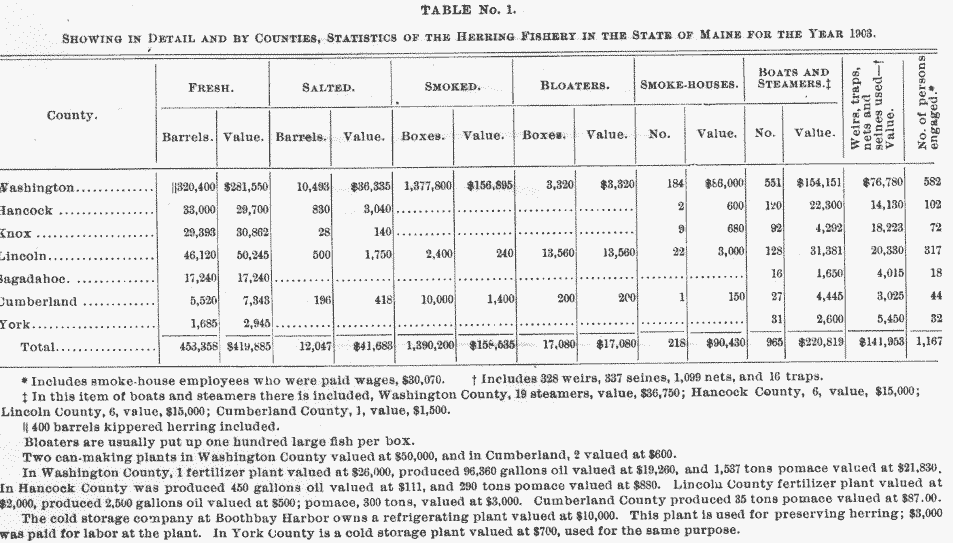
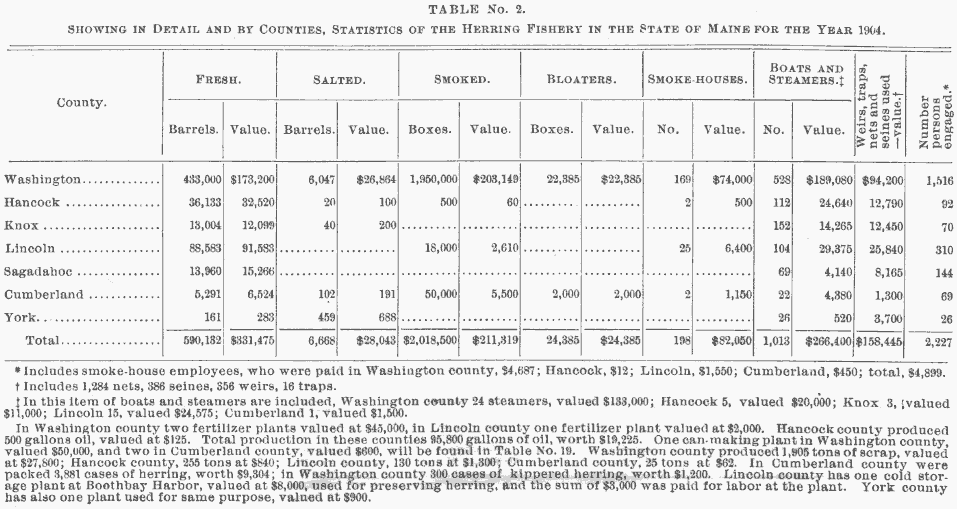
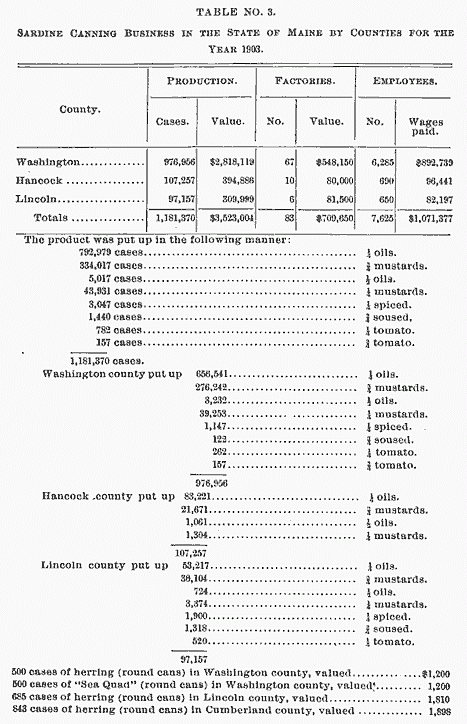
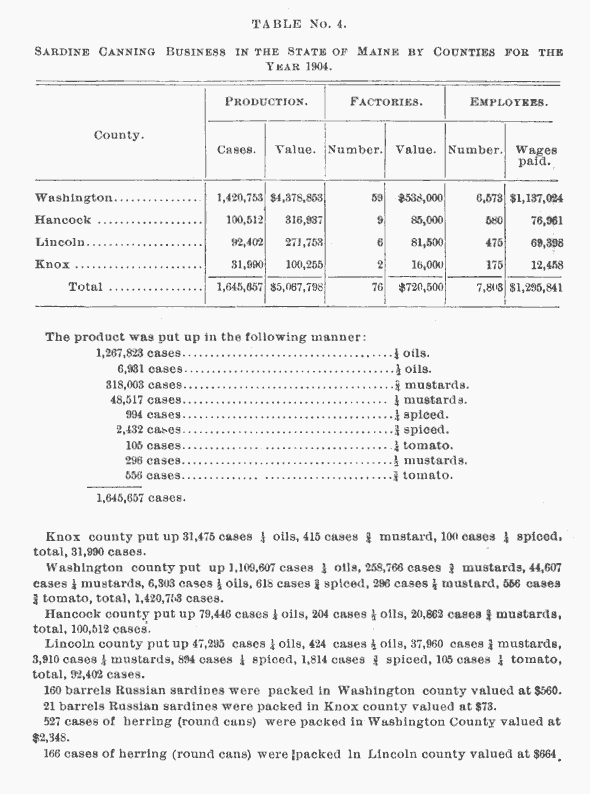
6,931 cases oils.
3I5'003 cases mustards.
48,517 cases mustards.
994 cases spiced.
2,432 cases spiced.
105 cases tomato.
296 cases mustards.
556 cases tomato.
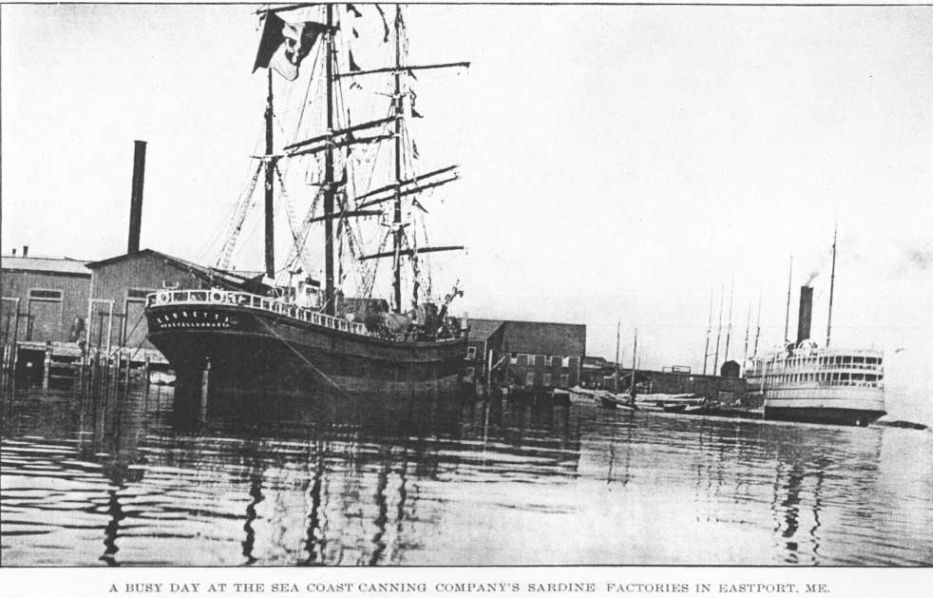
Approved March 28, 1903.
The lobsters were later returned and liberated in Maine waters.
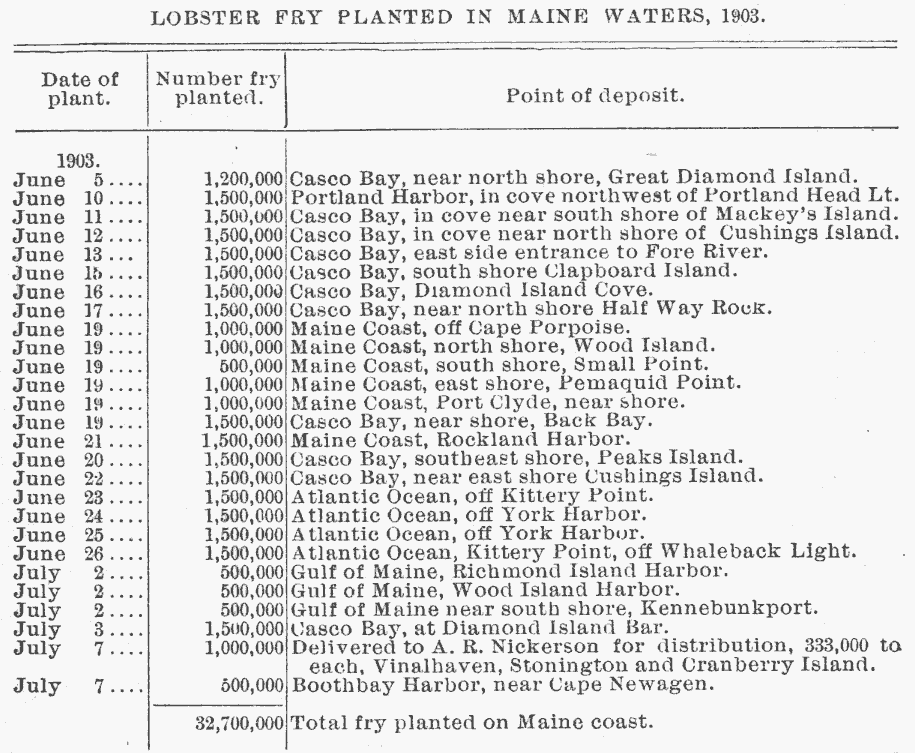
1903.
June 10 1,500,000 Portland Harbor, In cove northwest of Portland Head Lt. Casco
June 11 1,500,000 Casco Bay, in cove near south shore of Mackey's Island.
June 12 1,500,000 Casco Bay, in cove near north shore of Cushings Island.
June 13 1,500,000 Casco Bay, east side entrance to Fore River.
June 15 1,500,000 Casco Bay, south shore Clapboard Island.
June 16 1,500,000 Casco Bay, Diamond Island Cove.
June 17 1,500,000 Casco Bay, near north shore Half Way Rock.
June 19 1,000,000 Maine Coast, off Cape Porpoise.
June 19 1,000,000 Maine Coast, north shore, Wood Island.
June 19 500,000 Maine Coast, south shore, Small Point.
June 19 1,000,000 Maine Coast, east shore, Pemaquid Point.
June 19 1,000,000 Maine Coast, Port Clyde, near shore.
June 19 1,500,000 Casco Bay, near shore, Back Bay.
June 21 1,500,000 Maine Coast, Rockland Harbor.
June 20 1,500,000 Casco Bay, southeast shore, Peaks Island.
June 22 1,500,000 Casco Bay, near east shore Cushings Island.
June 23 1,500,000 Atlantic Ocean, off Kittery Point.
June 24 1,500,000 Atlantic Ocean, off York Harbor.
June 25 1,500,000 Atlantic Ocean, off York Harbor.
June 26 1,500,000 Atlantic Ocean, Kittery Point, off Whaleback Light.
July 2 500,000 Gulf of Maine, Wood Island Harbor.
July 2 500,000 Gulf of Maine near south shore, Kennebunkport.
July 3 1,500,000 Casco Bay, at Diamond Island Bar.
July 7 1,000,000 Delivered to A. R. Nickerson for distribution, 333,000 to each,
July 7 500,000 Vinalhaven, Stonington and Cranberry Island. Boothbay Harbor, near Cape Newagen.
Number taken to the U. S. Hatchery at Gloucester, Mass. 1,646
Impounded at the reserve at Bristol, and subsequently taken to the hatchery 8,638
Number liberated at time and place of purchase 6,232
Number punched 3d time 18 35
Number punched 4th time. 9 7
Number punched 5th time — 1
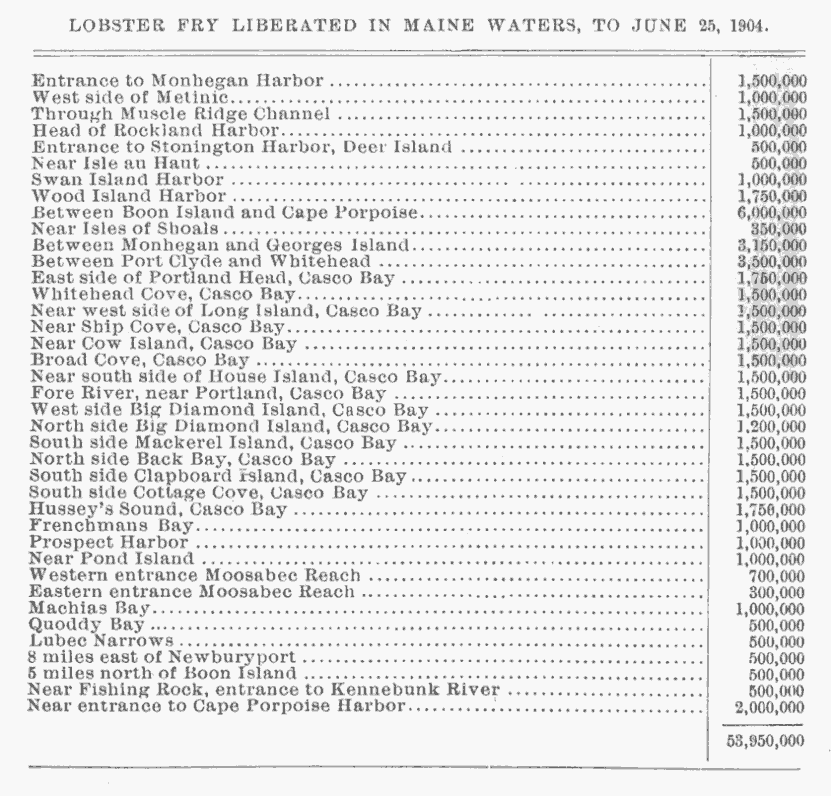
West side of Metinic 1,000,000
Through Muscle Ridge Channel 1,500,000
Head of Rockland Harbor 1,000,000
Entrance to Stonington Harbor, Deer Island 500,000
Near Isle au Haut 500,000
Swan Island Harbor 1,000,000
Wood Island Harbor 1,750,000
Between Boon Island and Cape Porpoise 6,000,000
Near Isles of Shoals 350,000
Between Monhegan and Georges Island 3,150,000
Between Port Clyde and Whitehead 3,500,000
East side of Portland Head, Casco Bay 1,750,000
Whitehead Cove, Casco Bay 1,500,000
Near west side of Long Island, Casco Bay 1,500,000
Near Ship Cove, Casco Bay 1,500,000
Near Cow Island, Casco Bay 1,500,000
Broad Cove., Casco Bay 1,500,000
Near south side of House Island, Casco Bay 1,500,000
Fore River, near Portland, Casco Bay 1,500,000
West side Big Diamond Island, Casco Bay 1,500,000
North side Big Diamond Island, Casco Bay 1.200,000
South side Mackerel Island, Casco Bay 1,500,000
North side Back Bay, Casco Bay 1.500,000
South aide Clapboard Island, Casco Bay 1,500,000
South side Cottage Cove, Casco Bay 1,500,000
Hussey's Sound, Casco Bay 1,750,000
Frenchmans Bay 1,000,000
Prospect Harbor 1,000,000
Near Pond Island 1,000,000
Western entrance Moosabec Reach 700,000
Eastern entrance Moosabec Reach 300,000
Machias Bay 1,000,000
Quoddy Bay 500,000
Lubec Narrows 500,000
8 miles east of Newburyport 500,000
5 miles north of Boon Island 500,000
Near Fishing Rock, entrance to Kennebunk River 500,000
Near entrance to Cape Porpoise Harbor 2,000,000
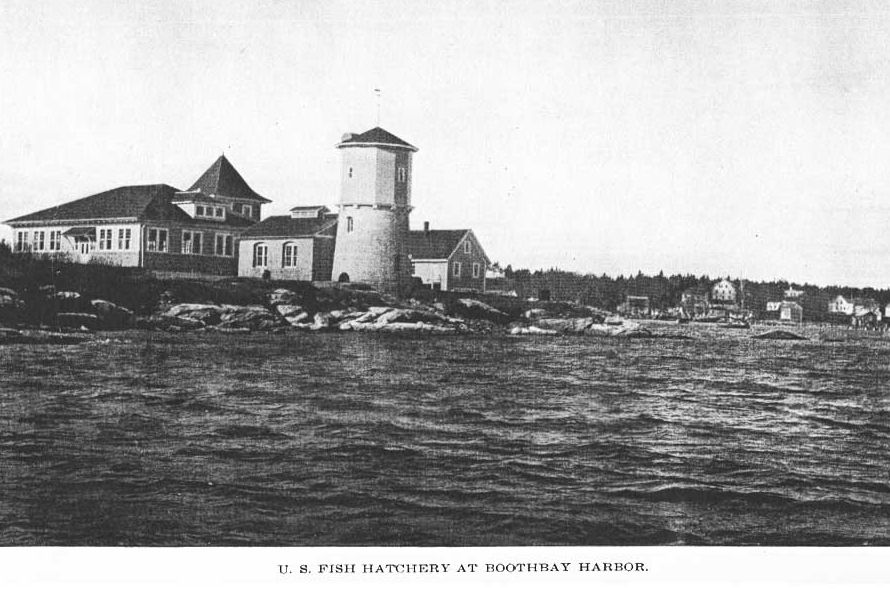
1897, 48;
1898, 44;
1899, 38;
1900, 44;
1901, 46;
1902, 48,
1903, 49.
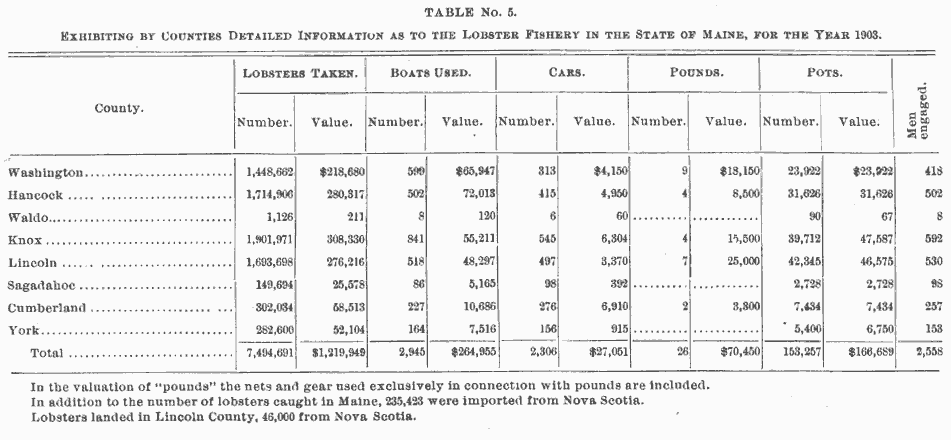
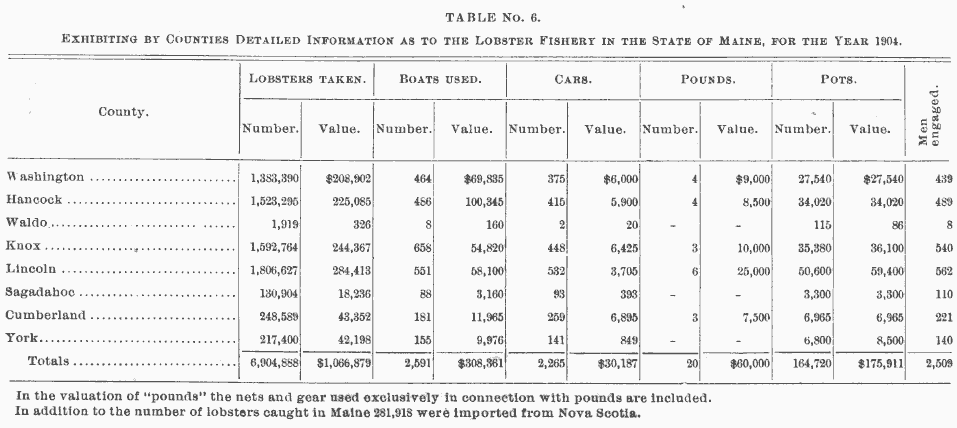
BENJ. THOMPSON. P. S.
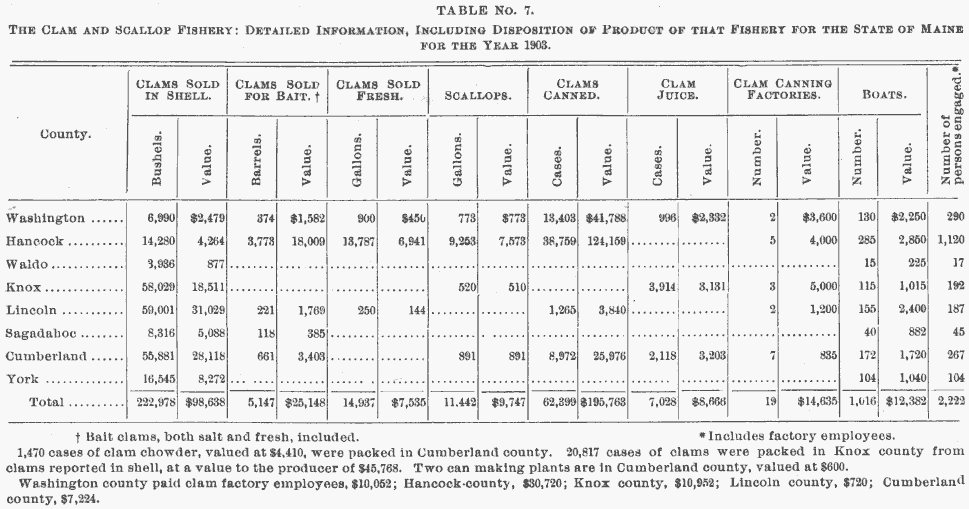
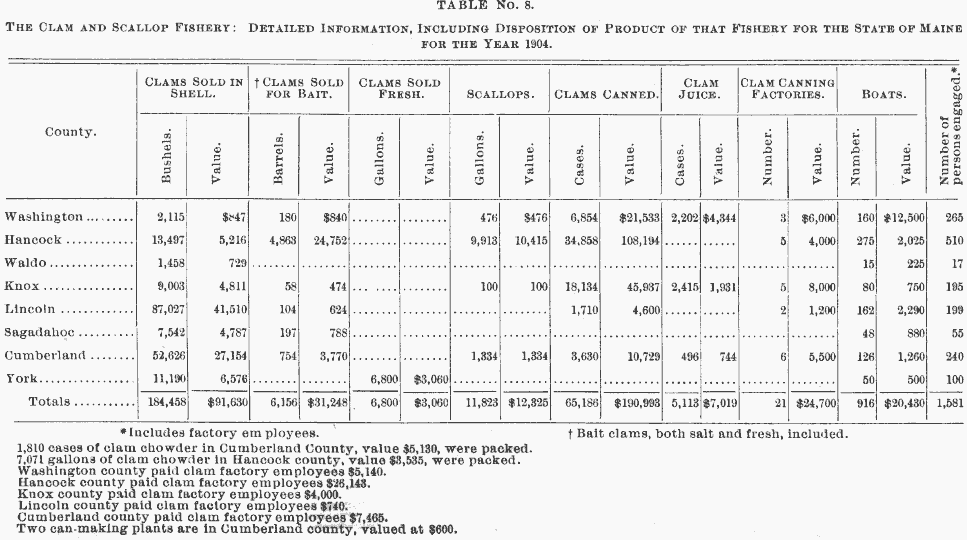
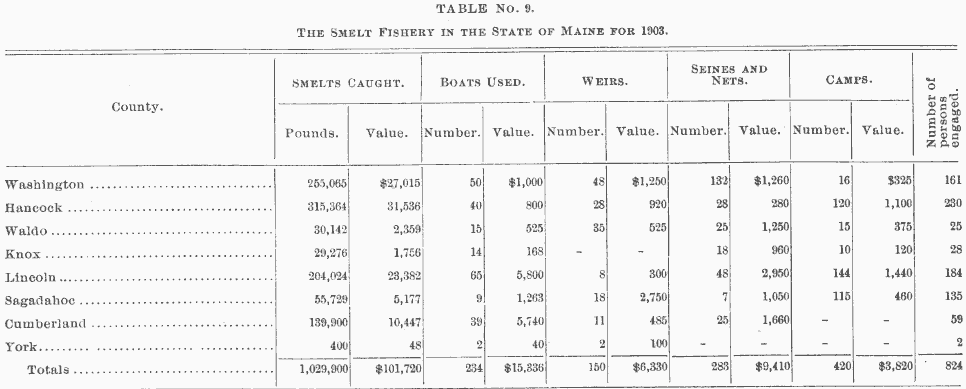
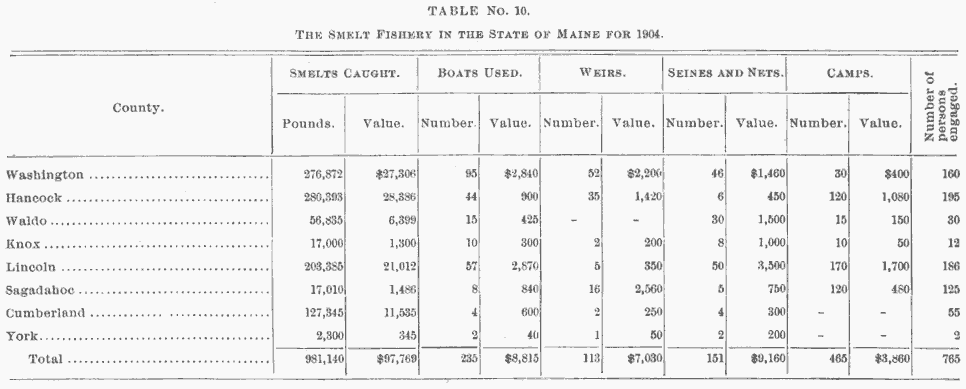
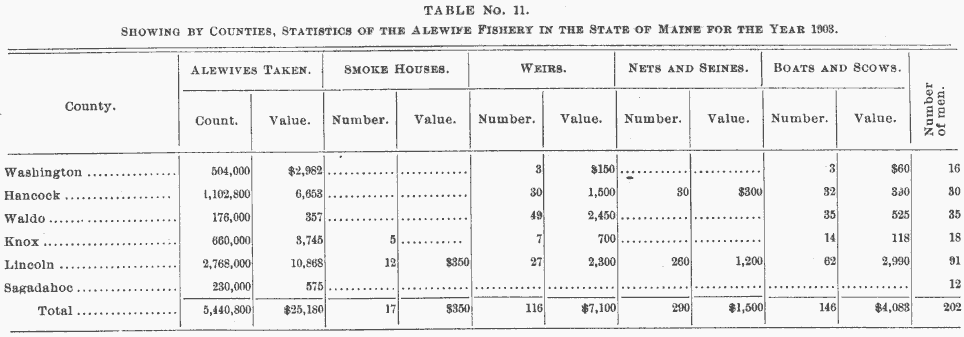
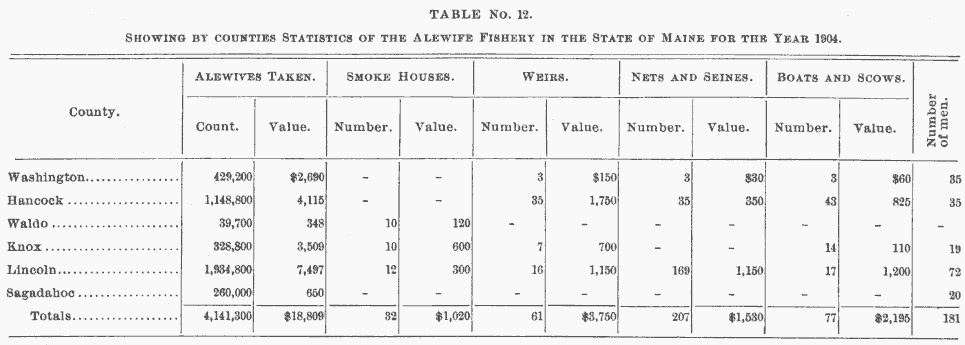
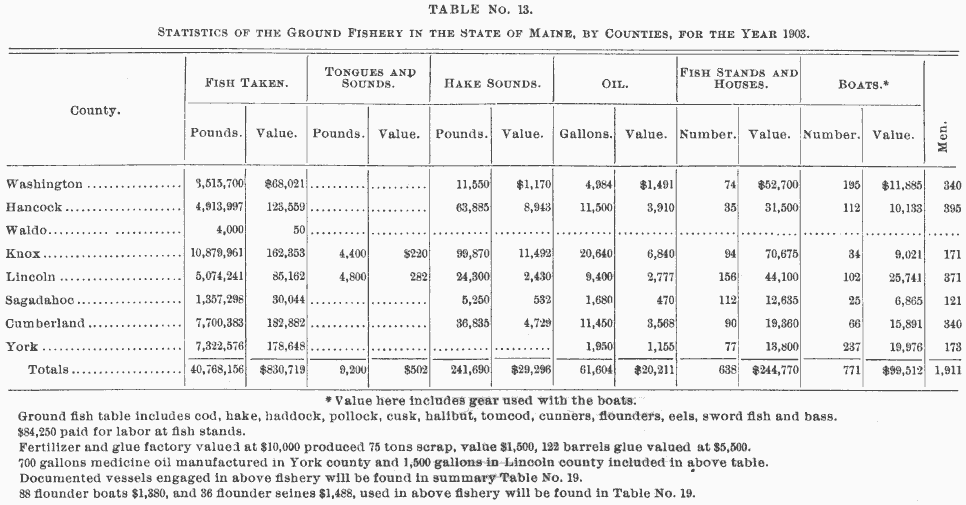
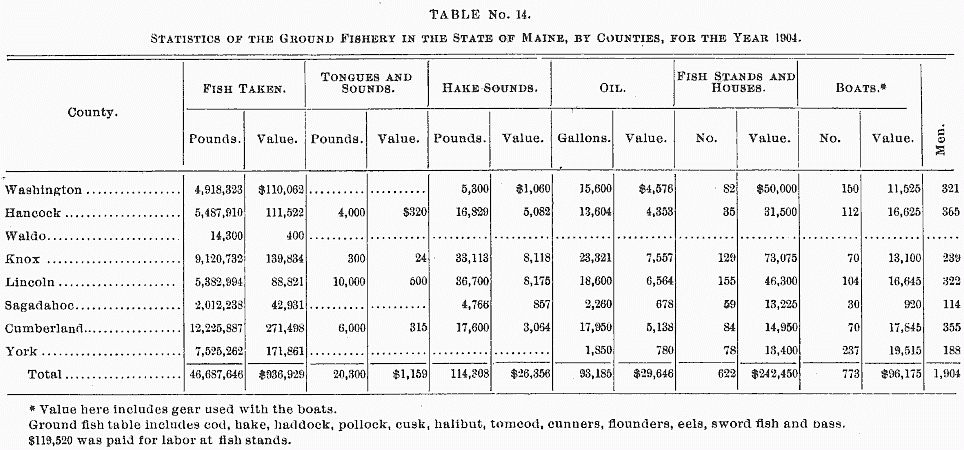
TABLE No. 15.
The Mackerel Fishery for the years 1903 & 1904.
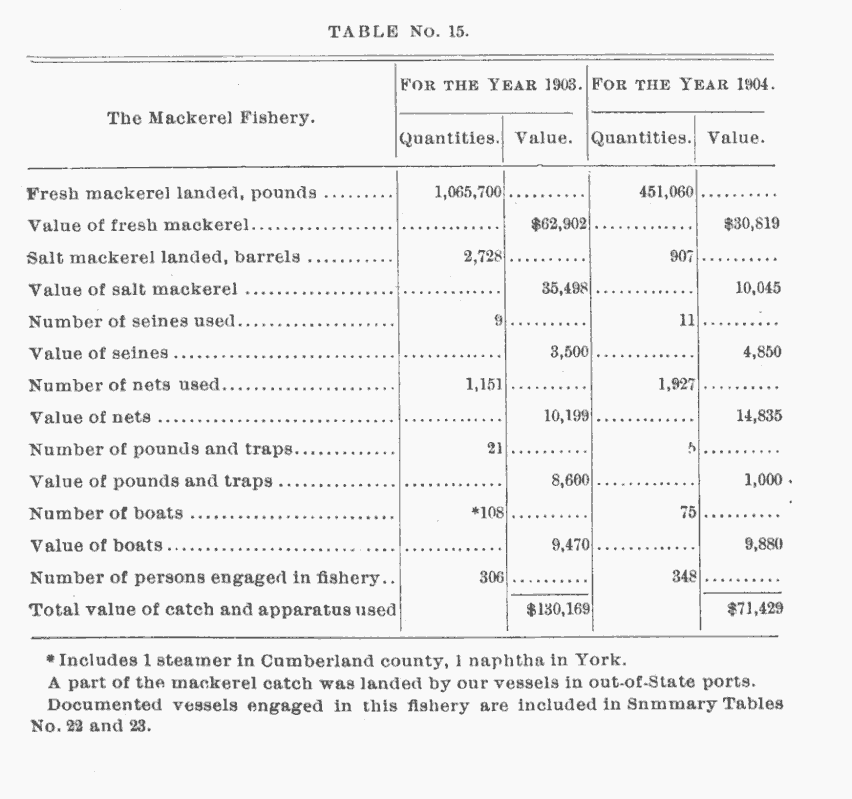
Quantities. Value. Quantities. Value.
Fresh mackerel landed, pounds 1,065,700 451,060
Value of fresh mackerel $62,902 $30,819
Salt mackerel landed, barrels 2,728 907
Value of salt mackerel 35,498 10,045
Number of seines used 9 11
Value of seines 3,500 4,850
Number of nets used 1,151 1,927
Value of nets 10,199 14,835
Number of pounds and traps 21 11
Value of pounds and traps 8,600 1,000.
Number of boats *108 75
Value of boats 9,470 9,880
Number of persons engaged in fishery. 306 348
Total value of catch and apparatus used $130,169 $71,429
A part of the mackerel catch was landed by our vessels in out-of-State ports. Documented vessels engaged in this fishery are included in Summary Tables No. 22 and 23.
The Shad Fishery for the years 1903 & 1904
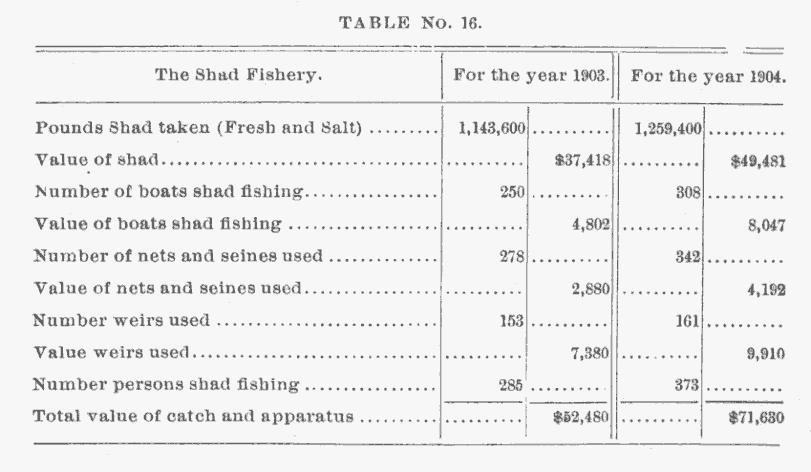
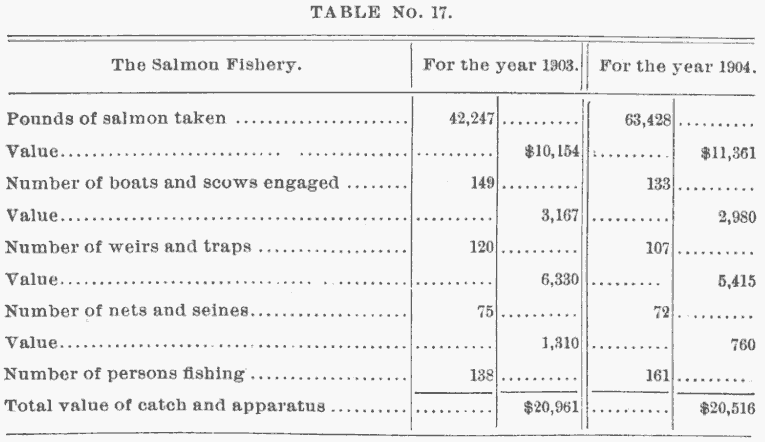
Total value of catch and apparatus: 1903: $20,961. 1904: $20,516
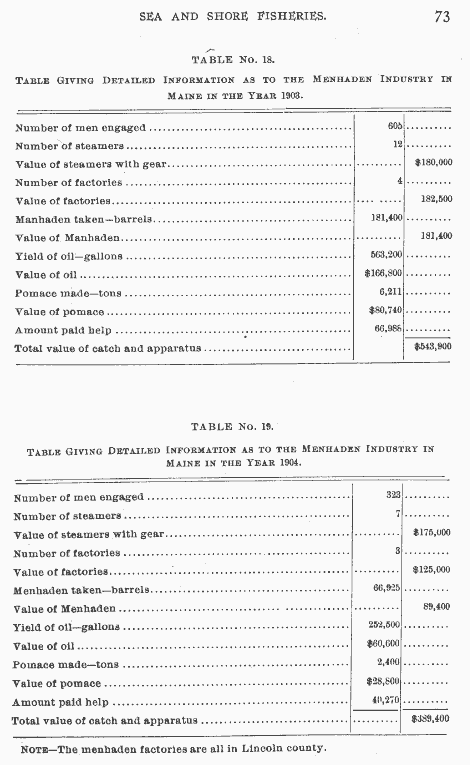
Number of steamers 12
Value of steamers with gear $180,000
Number of factories 4
Value of factories 182,500
Menhaden taken—barrels 181,400
Value of Menhaden 181,400
Yield of oil-gallons 563,200
Value of oil $166,800
Pomace made—tons 6,211
Value of pomace 80,740
Amount paid help 66,986
Total value of catch and apparatus $543,900
Number of steamers 7
Value of steamers with gear $175,000
Number of factories 3
Value of factories $125,000
Menhaden taken—barrels 66,925
Value of Menhaden 89,400
Yield of oil—gallons 252,500
Value of oil $60,600
Pomace made—tons 2,400
Value of pomace $28,800
Amount paid help 40,270
Summary of the Vessels, Boats and Apparatus Used and the Value, Showing by Fisheries Total Investment in the State of Maine, November 30, 1903
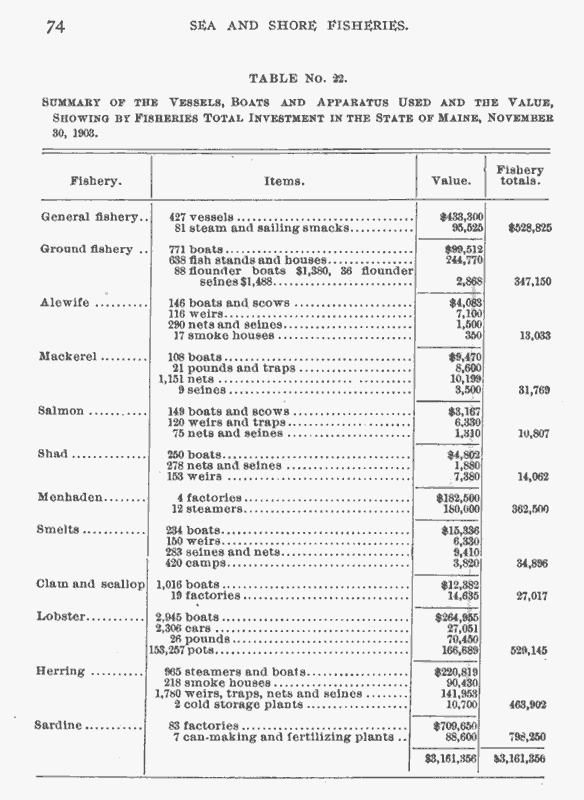
Summary of the Vessels, Boats and Apparatus Used and the Value, Showing
By Fisheries the Total Investment in the State of Maine, Nov. 30,1904
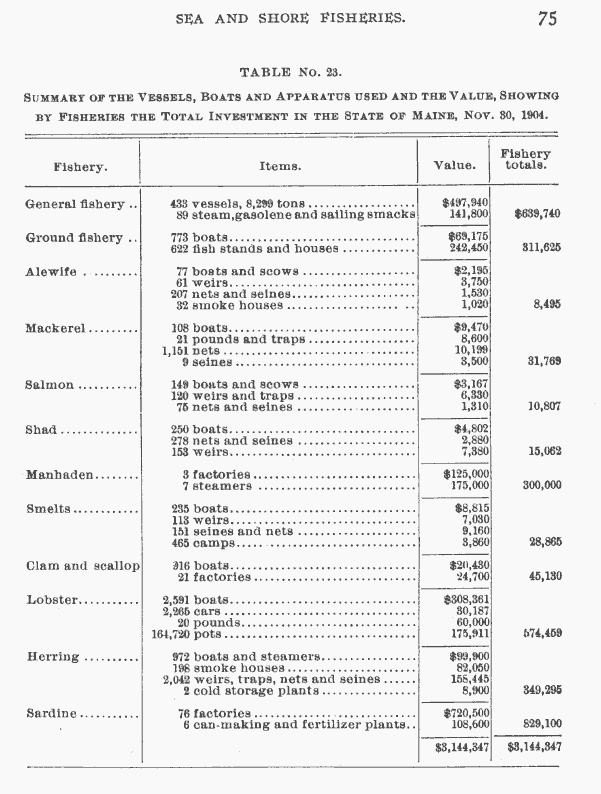
Showing Number of Persons Engaged in the Several Fisheries of the
State of Maine, by Counties, for the Year 1903.
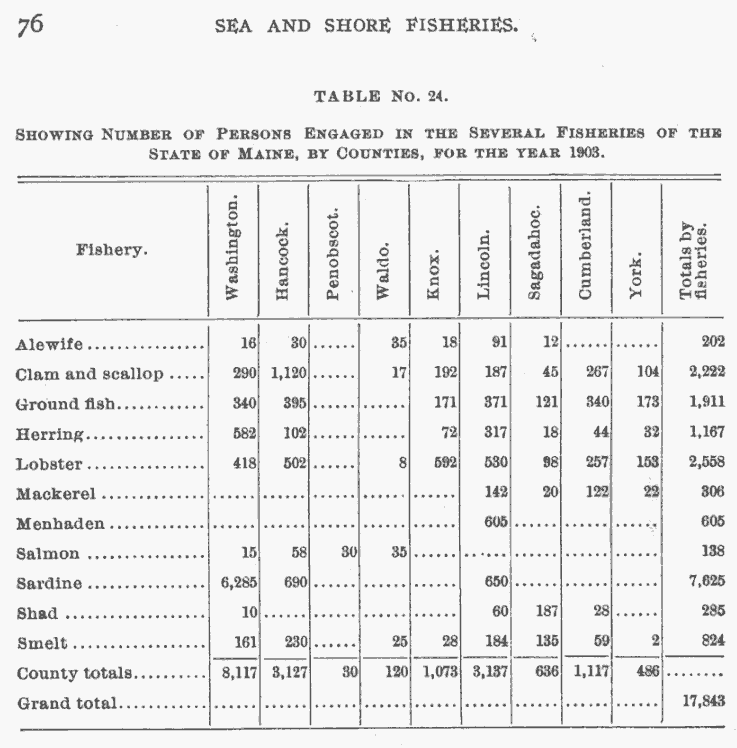
Showing Number of Persons Engaged in the Several Fisheries of the State of Maine, by Counties, for the Year 1904.
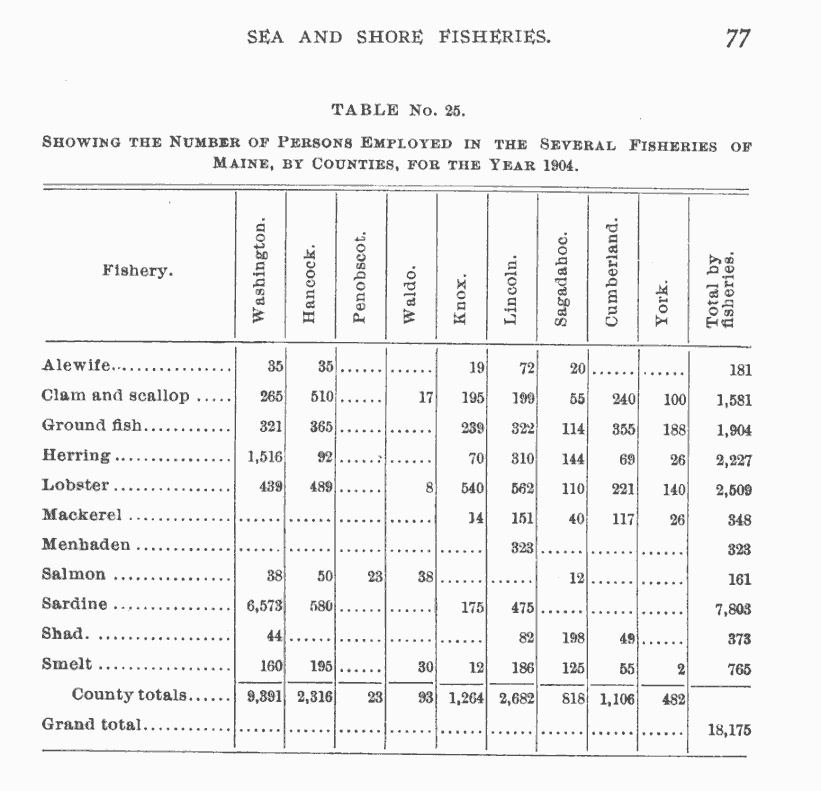
LIST OF FISH WARDENS NOW IN COMMISSION.
J. F. Goldthwaite Biddeford
George A. Dow. Portland
Richard Orr Orr's Island
Fred Mitchell Long Island
A. C. Johnson. Ashdale
R. T. York Damariscotta Mills
N. J. Hanna New Harbor
C. E. Sherman Boothbay Harbor
Levi E. Wade Rockland
A. J. Rawley Tenants Harbor
George W. Frisbee Belfast
Thomas E. Sullivan Bangor
S. P. Cousins East Lamoine
F. L. Hodgkins. Lamoine
V. M. Trundy. Oceanville
B. F. Howard Deer Isle
W. A. Henderson Cutler
P. M. Kane Eastport
W. W. Blood Milbridge
D. O. French Jonesport
F. A. Townsend Calais
I. H. Snow Brunswick
J. A. Foster E. Machias
Albin Avery North Lubec
J. H. McDiarmid Eastport
Alfred Small Lubec
J. E. Kelley. Boothbay
S. P. Cousins East Lamoine
W. A. Henderson Cutler
W. J. Fisher. Eastport
W. W. Blood Milbridge
P. M. Kane Eastport
A. J. Rawley Tenants Harbor
D. O. French Jonesport
F. M. Trundy. Oceanville
Levi H. Wade Rockland
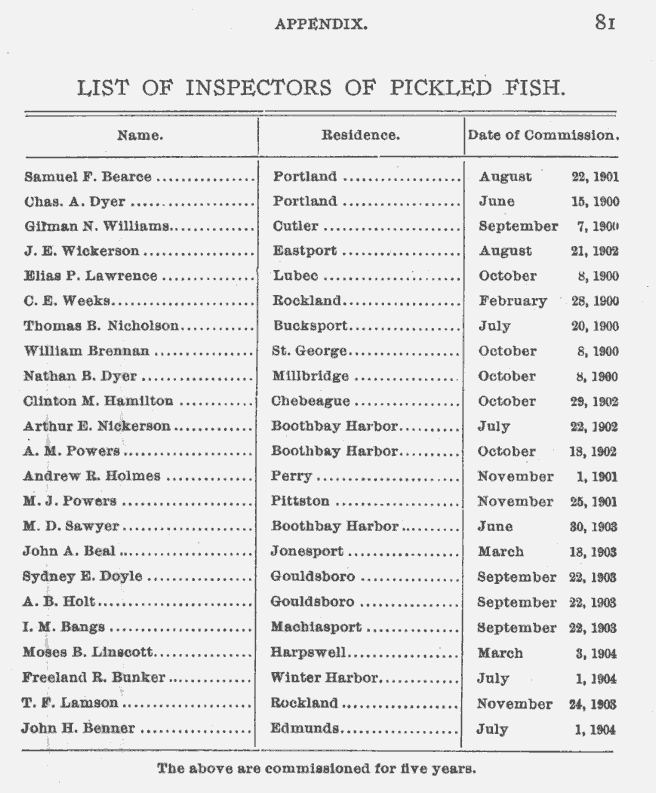
Name. Residence. Date of Commission.
Samuel F. Bearce Portland August 22, 1901
Chas. A. Dyer Portland June 15,1900
Gilman N. Williams Cutler September 7, 1900
J. E. Wickerson Eastport August 21, 1902
Elias P. Lawrence Lubec October 8, 1900
C. E. Weeks Rockland February 28, 1900
Thomas B. Nicholson Bucksport July 20, 1900
William Brennan St. George October 8, 1900
Nathan B. Dyer Millbridge October 8, 1900
Clinton M. Hamilton Cbebeague October 29, 1902
Arthur E. Nickerson Boothbay Harbor July 22, 1902
A. M. Powers Boothbay Harbor October 18, 1902
Andrew R. Holmes Perry November 1, 1901
M. J. Powers Pittston November 25, 1901
M. D. Sawyer Boothbay Harbor June 30, 1903
John A. Beal. Jonesport March 18, 1903
Sydney E. Doyle Gouldsboro September 22, 1903
A. B. Holt Gouldsboro September 22, 1903
I. M. Bangs Maebiasport September 22, 1903
Moses B. Linscott Harpswell March 3, 1904
Freeland R. Bunker Winter Harbor July 1, 1904
T. F. Lamson Rockland November 24, 1903
John H. Benner Edmunds July 1, 1904
